Adaptive Robust Control for a Class of Uncertain MIMO Non-affine Nonlinear Systems
国际自动化与计算杂志.英文版.

国际自动化与计算杂志.英文版.1.Improved Exponential Stability Criteria for Uncertain Neutral System with Nonlinear Parameter PerturbationsFang Qiu,Ban-Tong Cui2.Robust Active Suspension Design Subject to Vehicle Inertial Parameter VariationsHai-Ping Du,Nong Zhang3.Delay-dependent Non-fragile H∞ Filtering for Uncertain Fuzzy Systems Based on Switching Fuzzy Model and Piecewise Lyapunov FunctionZhi-Le Xia,Jun-Min Li,Jiang-Rong Li4.Observer-based Adaptive Iterative Learning Control for Nonlinear Systems with Time-varying DelaysWei-Sheng Chen,Rui-Hong Li,Jing Li5.H∞ Output Feedback Control for Stochastic Systems with Mode-dependent Time-varying Delays and Markovian Jump ParametersXu-Dong Zhao,Qing-Shuang Zeng6.Delay and Its Time-derivative Dependent Robust Stability of Uncertain Neutral Systems with Saturating ActuatorsFatima El Haoussi,El Houssaine Tissir7.Parallel Fuzzy P+Fuzzy I+Fuzzy D Controller:Design and Performance EvaluationVineet Kumar,A.P.Mittal8.Observers for Descriptor Systems with Slope-restricted NonlinearitiesLin-Na Zhou,Chun-Yu Yang,Qing-Ling Zhang9.Parameterized Solution to a Class of Sylvester MatrixEquationsYu-Peng Qiao,Hong-Sheng Qi,Dai-Zhan Cheng10.Indirect Adaptive Fuzzy and Impulsive Control of Nonlinear SystemsHai-Bo Jiang11.Robust Fuzzy Tracking Control for Nonlinear Networked Control Systems with Integral Quadratic ConstraintsZhi-Sheng Chen,Yong He,Min Wu12.A Power-and Coverage-aware Clustering Scheme for Wireless Sensor NetworksLiang Xue,Xin-Ping Guan,Zhi-Xin Liu,Qing-Chao Zheng13.Guaranteed Cost Active Fault-tolerant Control of Networked Control System with Packet Dropout and Transmission DelayXiao-Yuan Luo,Mei-Jie Shang,Cai-Lian Chen,Xin-Ping Guanparison of Two Novel MRAS Based Strategies for Identifying Parameters in Permanent Magnet Synchronous MotorsKan Liu,Qiao Zhang,Zi-Qiang Zhu,Jing Zhang,An-Wen Shen,Paul Stewart15.Modeling and Analysis of Scheduling for Distributed Real-time Embedded SystemsHai-Tao Zhang,Gui-Fang Wu16.Passive Steganalysis Based on Higher Order Image Statistics of Curvelet TransformS.Geetha,Siva S.Sivatha Sindhu,N.Kamaraj17.Movement Invariants-based Algorithm for Medical Image Tilt CorrectionMei-Sen Pan,Jing-Tian Tang,Xiao-Li Yang18.Target Tracking and Obstacle Avoidance for Multi-agent SystemsJing Yan,Xin-Ping Guan,Fu-Xiao Tan19.Automatic Generation of Optimally Rigid Formations Using Decentralized MethodsRui Ren,Yu-Yan Zhang,Xiao-Yuan Luo,Shao-Bao Li20.Semi-blind Adaptive Beamforming for High-throughput Quadrature Amplitude Modulation SystemsSheng Chen,Wang Yao,Lajos Hanzo21.Throughput Analysis of IEEE 802.11 Multirate WLANs with Collision Aware Rate Adaptation AlgorithmDhanasekaran Senthilkumar,A. Krishnan22.Innovative Product Design Based on Customer Requirement Weight Calculation ModelChen-Guang Guo,Yong-Xian Liu,Shou-Ming Hou,Wei Wang23.A Service Composition Approach Based on Sequence Mining for Migrating E-learning Legacy System to SOAZhuo Zhang,Dong-Dai Zhou,Hong-Ji Yang,Shao-Chun Zhong24.Modeling of Agile Intelligent Manufacturing-oriented Production Scheduling SystemZhong-Qi Sheng,Chang-Ping Tang,Ci-Xing Lv25.Estimation of Reliability and Cost Relationship for Architecture-based SoftwareHui Guan,Wei-Ru Chen,Ning Huang,Hong-Ji Yang1.A Computer-aided Design System for Framed-mould in Autoclave ProcessingTian-Guo Jin,Feng-Yang Bi2.Wear State Recognition of Drills Based on K-means Cluster and Radial Basis Function Neural NetworkXu Yang3.The Knee Joint Design and Control of Above-knee Intelligent Bionic Leg Based on Magneto-rheological DamperHua-Long Xie,Ze-Zhong Liang,Fei Li,Li-Xin Guo4.Modeling of Pneumatic Muscle with Shape Memory Alloy and Braided SleeveBin-Rui Wang,Ying-Lian Jin,Dong Wei5.Extended Object Model for Product Configuration DesignZhi-Wei Xu,Ze-Zhong Liang,Zhong-Qi Sheng6.Analysis of Sheet Metal Extrusion Process Using Finite Element MethodXin-Cun Zhuang,Hua Xiang,Zhen Zhao7.Implementation of Enterprises' Interoperation Based on OntologyXiao-Feng Di,Yu-Shun Fan8.Path Planning Approach in Unknown EnvironmentTing-Kai Wang,Quan Dang,Pei-Yuan Pan9.Sliding Mode Variable Structure Control for Visual Servoing SystemFei Li,Hua-Long Xie10.Correlation of Direct Piezoelectric Effect on EAPap under Ambient FactorsLi-Jie Zhao,Chang-Ping Tang,Peng Gong11.XML-based Data Processing in Network Supported Collaborative DesignQi Wang,Zhong-Wei Ren,Zhong-Feng Guo12.Production Management Modelling Based on MASLi He,Zheng-Hao Wang,Ke-Long Zhang13.Experimental Tests of Autonomous Ground Vehicles with PreviewCunjia Liu,Wen-Hua Chen,John Andrews14.Modelling and Remote Control of an ExcavatorYang Liu,Mohammad Shahidul Hasan,Hong-Nian Yu15.TOPSIS with Belief Structure for Group Belief Multiple Criteria Decision MakingJiang Jiang,Ying-Wu Chen,Da-Wei Tang,Yu-Wang Chen16.Video Analysis Based on Volumetric Event DetectionJing Wang,Zhi-Jie Xu17.Improving Decision Tree Performance by Exception HandlingAppavu Alias Balamurugan Subramanian,S.Pramala,B.Rajalakshmi,Ramasamy Rajaram18.Robustness Analysis of Discrete-time Indirect Model Reference Adaptive Control with Normalized Adaptive LawsQing-Zheng Gao,Xue-Jun Xie19.A Novel Lifecycle Model for Web-based Application Development in Small and Medium EnterprisesWei Huang,Ru Li,Carsten Maple,Hong-Ji Yang,David Foskett,Vince Cleaver20.Design of a Two-dimensional Recursive Filter Using the Bees AlgorithmD. T. Pham,Ebubekir Ko(c)21.Designing Genetic Regulatory Networks Using Fuzzy Petri Nets ApproachRaed I. Hamed,Syed I. Ahson,Rafat Parveen1.State of the Art and Emerging Trends in Operations and Maintenance of Offshore Oil and Gas Production Facilities: Some Experiences and ObservationsJayantha P.Liyanage2.Statistical Safety Analysis of Maintenance Management Process of Excavator UnitsLjubisa Papic,Milorad Pantelic,Joseph Aronov,Ajit Kumar Verma3.Improving Energy and Power Efficiency Using NComputing and Approaches for Predicting Reliability of Complex Computing SystemsHoang Pham,Hoang Pham Jr.4.Running Temperature and Mechanical Stability of Grease as Maintenance Parameters of Railway BearingsJan Lundberg,Aditya Parida,Peter S(o)derholm5.Subsea Maintenance Service Delivery: Mapping Factors Influencing Scheduled Service DurationEfosa Emmanuel Uyiomendo,Tore Markeset6.A Systemic Approach to Integrated E-maintenance of Large Engineering PlantsAjit Kumar Verma,A.Srividya,P.G.Ramesh7.Authentication and Access Control in RFID Based Logistics-customs Clearance Service PlatformHui-Fang Deng,Wen Deng,Han Li,Hong-Ji Yang8.Evolutionary Trajectory Planning for an Industrial RobotR.Saravanan,S.Ramabalan,C.Balamurugan,A.Subash9.Improved Exponential Stability Criteria for Recurrent Neural Networks with Time-varying Discrete and Distributed DelaysYuan-Yuan Wu,Tao Li,Yu-Qiang Wu10.An Improved Approach to Delay-dependent Robust Stabilization for Uncertain Singular Time-delay SystemsXin Sun,Qing-Ling Zhang,Chun-Yu Yang,Zhan Su,Yong-Yun Shao11.Robust Stability of Nonlinear Plants with a Non-symmetric Prandtl-Ishlinskii Hysteresis ModelChang-An Jiang,Ming-Cong Deng,Akira Inoue12.Stability Analysis of Discrete-time Systems with Additive Time-varying DelaysXian-Ming Tang,Jin-Shou Yu13.Delay-dependent Stability Analysis for Markovian Jump Systems with Interval Time-varying-delaysXu-Dong Zhao,Qing-Shuang Zeng14.H∞ Synchronization of Chaotic Systems via Delayed Feedback ControlLi Sheng,Hui-Zhong Yang15.Adaptive Fuzzy Observer Backstepping Control for a Class of Uncertain Nonlinear Systems with Unknown Time-delayShao-Cheng Tong,Ning Sheng16.Simulation-based Optimal Design of α-β-γ-δ FilterChun-Mu Wu,Paul P.Lin,Zhen-Yu Han,Shu-Rong Li17.Independent Cycle Time Assignment for Min-max SystemsWen-De Chen,Yue-Gang Tao,Hong-Nian Yu1.An Assessment Tool for Land Reuse with Artificial Intelligence MethodDieter D. Genske,Dongbin Huang,Ariane Ruff2.Interpolation of Images Using Discrete Wavelet Transform to Simulate Image Resizing as in Human VisionRohini S. Asamwar,Kishor M. Bhurchandi,Abhay S. Gandhi3.Watermarking of Digital Images in Frequency DomainSami E. I. Baba,Lala Z. Krikor,Thawar Arif,Zyad Shaaban4.An Effective Image Retrieval Mechanism Using Family-based Spatial Consistency Filtration with Object RegionJing Sun,Ying-Jie Xing5.Robust Object Tracking under Appearance Change ConditionsQi-Cong Wang,Yuan-Hao Gong,Chen-Hui Yang,Cui-Hua Li6.A Visual Attention Model for Robot Object TrackingJin-Kui Chu,Rong-Hua Li,Qing-Ying Li,Hong-Qing Wang7.SVM-based Identification and Un-calibrated Visual Servoing for Micro-manipulationXin-Han Huang,Xiang-Jin Zeng,Min Wang8.Action Control of Soccer Robots Based on Simulated Human IntelligenceTie-Jun Li,Gui-Qiang Chen,Gui-Fang Shao9.Emotional Gait Generation for a Humanoid RobotLun Xie,Zhi-Liang Wang,Wei Wang,Guo-Chen Yu10.Cultural Algorithm for Minimization of Binary Decision Diagram and Its Application in Crosstalk Fault DetectionZhong-Liang Pan,Ling Chen,Guang-Zhao Zhang11.A Novel Fuzzy Direct Torque Control System for Three-level Inverter-fed Induction MachineShu-Xi Liu,Ming-Yu Wang,Yu-Guang Chen,Shan Li12.Statistic Learning-based Defect Detection for Twill FabricsLi-Wei Han,De Xu13.Nonsaturation Throughput Enhancement of IEEE 802.11b Distributed Coordination Function for Heterogeneous Traffic under Noisy EnvironmentDhanasekaran Senthilkumar,A. Krishnan14.Structure and Dynamics of Artificial Regulatory Networks Evolved by Segmental Duplication and Divergence ModelXiang-Hong Lin,Tian-Wen Zhang15.Random Fuzzy Chance-constrained Programming Based on Adaptive Chaos Quantum Honey Bee Algorithm and Robustness AnalysisHan Xue,Xun Li,Hong-Xu Ma16.A Bit-level Text Compression Scheme Based on the ACW AlgorithmHussein A1-Bahadili,Shakir M. Hussain17.A Note on an Economic Lot-sizing Problem with Perishable Inventory and Economies of Scale Costs:Approximation Solutions and Worst Case AnalysisQing-Guo Bai,Yu-Zhong Zhang,Guang-Long Dong1.Virtual Reality: A State-of-the-Art SurveyNing-Ning Zhou,Yu-Long Deng2.Real-time Virtual Environment Signal Extraction and DenoisingUsing Programmable Graphics HardwareYang Su,Zhi-Jie Xu,Xiang-Qian Jiang3.Effective Virtual Reality Based Building Navigation Using Dynamic Loading and Path OptimizationQing-Jin Peng,Xiu-Mei Kang,Ting-Ting Zhao4.The Skin Deformation of a 3D Virtual HumanXiao-Jing Zhou,Zheng-Xu Zhao5.Technology for Simulating Crowd Evacuation BehaviorsWen-Hu Qin,Guo-Hui Su,Xiao-Na Li6.Research on Modelling Digital Paper-cut PreservationXiao-Fen Wang,Ying-Rui Liu,Wen-Sheng Zhang7.On Problems of Multicomponent System Maintenance ModellingTomasz Nowakowski,Sylwia Werbinka8.Soft Sensing Modelling Based on Optimal Selection of Secondary Variables and Its ApplicationQi Li,Cheng Shao9.Adaptive Fuzzy Dynamic Surface Control for Uncertain Nonlinear SystemsXiao-Yuan Luo,Zhi-Hao Zhu,Xin-Ping Guan10.Output Feedback for Stochastic Nonlinear Systems with Unmeasurable Inverse DynamicsXin Yu,Na Duan11.Kalman Filtering with Partial Markovian Packet LossesBao-Feng Wang,Ge Guo12.A Modified Projection Method for Linear FeasibilityProblemsYi-Ju Wang,Hong-Yu Zhang13.A Neuro-genetic Based Short-term Forecasting Framework for Network Intrusion Prediction SystemSiva S. Sivatha Sindhu,S. Geetha,M. Marikannan,A. Kannan14.New Delay-dependent Global Asymptotic Stability Condition for Hopfield Neural Networks with Time-varying DelaysGuang-Deng Zong,Jia Liu hHTTp://15.Crosscumulants Based Approaches for the Structure Identification of Volterra ModelsHouda Mathlouthi,Kamel Abederrahim,Faouzi Msahli,Gerard Favier1.Coalition Formation in Weighted Simple-majority Games under Proportional Payoff Allocation RulesZhi-Gang Cao,Xiao-Guang Yang2.Stability Analysis for Recurrent Neural Networks with Time-varying DelayYuan-Yuan Wu,Yu-Qiang Wu3.A New Type of Solution Method for the Generalized Linear Complementarity Problem over a Polyhedral ConeHong-Chun Sun,Yan-Liang Dong4.An Improved Control Algorithm for High-order Nonlinear Systems with Unmodelled DynamicsNa Duan,Fu-Nian Hu,Xin Yu5.Controller Design of High Order Nonholonomic System with Nonlinear DriftsXiu-Yun Zheng,Yu-Qiang Wu6.Directional Filter for SAR Images Based on NonsubsampledContourlet Transform and Immune Clonal SelectionXiao-Hui Yang,Li-Cheng Jiao,Deng-Feng Li7.Text Extraction and Enhancement of Binary Images Using Cellular AutomataG. Sahoo,Tapas Kumar,B.L. Rains,C.M. Bhatia8.GH2 Control for Uncertain Discrete-time-delay Fuzzy Systems Based on a Switching Fuzzy Model and Piecewise Lyapunov FunctionZhi-Le Xia,Jun-Min Li9.A New Energy Optimal Control Scheme for a Separately Excited DC Motor Based Incremental Motion DriveMilan A.Sheta,Vivek Agarwal,Paluri S.V.Nataraj10.Nonlinear Backstepping Ship Course ControllerAnna Witkowska,Roman Smierzchalski11.A New Method of Embedded Fourth Order with Four Stages to Study Raster CNN SimulationR. Ponalagusamy,S. Senthilkumar12.A Minimum-energy Path-preserving Topology Control Algorithm for Wireless Sensor NetworksJin-Zhao Lin,Xian Zhou,Yun Li13.Synchronization and Exponential Estimates of Complex Networks with Mixed Time-varying Coupling DelaysYang Dai,YunZe Cai,Xiao-Ming Xu14.Step-coordination Algorithm of Traffic Control Based on Multi-agent SystemHai-Tao Zhang,Fang Yu,Wen Li15.A Research of the Employment Problem on Common Job-seekersand GraduatesBai-Da Qu。
adaptive control

Desired Performance ComparisonDecision
Adaptation Mechanism
Performance Measurement
Adaptation scheme
Adaptive Control – Landau, Lozano, M’Saad, Karimi
Adaptive Control versus Conventional Feedback Control
y
u
Plant
Desired Performance
Adaptation Scheme
Reference Controller
u
Plant
y
An adaptive control structure
Remark: An adaptive control system is nonlinear since controller parameters will depend upon u and y
Adaptive Control – Landau, Lozano, M’Saad, Karimi
Conventional Control – Adaptive Control - Robust Control
Conventional versus Adaptive
Conventional versus Robust
Adaptive Control – Landau, Lozano, M’Saad, Karimi
Conceptual Structures
Desired Performance Controller Design Method Plant Model
Robust Control
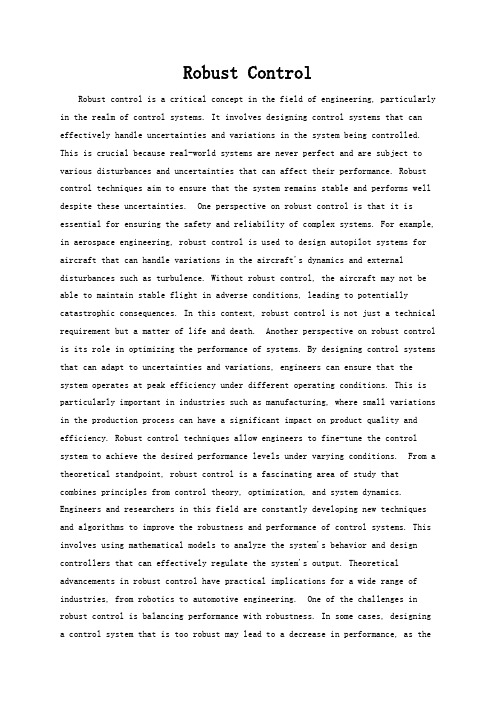
Robust ControlRobust control is a critical concept in the field of engineering, particularly in the realm of control systems. It involves designing control systems that can effectively handle uncertainties and variations in the system being controlled. This is crucial because real-world systems are never perfect and are subject to various disturbances and uncertainties that can affect their performance. Robust control techniques aim to ensure that the system remains stable and performs well despite these uncertainties. One perspective on robust control is that it is essential for ensuring the safety and reliability of complex systems. For example, in aerospace engineering, robust control is used to design autopilot systems for aircraft that can handle variations in the aircraft's dynamics and external disturbances such as turbulence. Without robust control, the aircraft may not be able to maintain stable flight in adverse conditions, leading to potentially catastrophic consequences. In this context, robust control is not just a technical requirement but a matter of life and death. Another perspective on robust control is its role in optimizing the performance of systems. By designing control systems that can adapt to uncertainties and variations, engineers can ensure that the system operates at peak efficiency under different operating conditions. This is particularly important in industries such as manufacturing, where small variations in the production process can have a significant impact on product quality and efficiency. Robust control techniques allow engineers to fine-tune the control system to achieve the desired performance levels under varying conditions. From a theoretical standpoint, robust control is a fascinating area of study that combines principles from control theory, optimization, and system dynamics. Engineers and researchers in this field are constantly developing new techniques and algorithms to improve the robustness and performance of control systems. This involves using mathematical models to analyze the system's behavior and design controllers that can effectively regulate the system's output. Theoretical advancements in robust control have practical implications for a wide range of industries, from robotics to automotive engineering. One of the challenges in robust control is balancing performance with robustness. In some cases, designing a control system that is too robust may lead to a decrease in performance, as thesystem may be overly conservative in its response to uncertainties. On the other hand, a control system that prioritizes performance over robustness may be more susceptible to disturbances and variations, leading to instability or poor performance. Engineers must carefully consider these trade-offs when designing control systems to ensure that they strike the right balance between performance and robustness. In recent years, advances in technology have enabled engineers to develop more sophisticated and efficient robust control techniques. Machine learning and artificial intelligence, for example, have been used to improve the performance of control systems by allowing them to adapt and learn from data in real-time. These advancements have opened up new possibilities for designing control systems that are not only robust but also adaptive and intelligent. The integration of these technologies into robust control systems is likely to drive further innovation and improvements in the field. In conclusion, robust control is a crucial aspect of engineering that plays a vital role in ensuring the safety, reliability, and performance of complex systems. From aerospace to manufacturing, robust control techniques are used to design control systems that can handle uncertainties and variations in the system being controlled. Theoretical advancements in robust control continue to drive innovation in the field, while technological advancements such as machine learning are opening up newpossibilities for designing more adaptive and intelligent control systems. Engineers must carefully balance performance with robustness when designingcontrol systems to ensure optimal system performance under varying conditions.。
INTERNATIONAL JOURNAL OF ROBUST AND NONLINEAR CONTROL

SUMMARY In this paper, a modular modification of the adaptive robust control (ARC) technique is presented. The modular design has all of the original ARC properties with an estimation-based update law instead of a Lyapunov-based update law. In this design, the controller is divided into two modules: a control module and an identification module. A key new idea is to set a priori bounds on the time derivatives of the estimates to be maintained by the update law. As a result, their effects on the system tracking accuracy can be dominated by the control law. A modification is proposed for the standard gradient and least-square update laws to guarantee the bounds. This modification also makes the controller robust against the generalized (unparameterized) uncertainties considered in the ARC formulation while allowing asymptotic output tracking without the generalized uncertainties. Both the ARC and the modular ARC techniques are applied to a force control problem for an active suspension system. Simulations and experimental results are provided to show that the update law of the modular design is less sensitive to measurement noise which results in smaller force tracking error and smaller control gain. Copyright # 2004 John Wiley & Sons, Ltd.
Robust Control and Estimation

Robust Control and Estimation Robust control and estimation are critical components in the field of engineering, particularly in ensuring the stability and performance of complex systems. These techniques are essential in dealing with uncertainties and disturbances that can affect the behavior of a system. Robust control involves designing controllers that can handle variations in system parameters and external disturbances, while robust estimation focuses on accurately estimating the state of a system despite uncertainties in measurements and disturbances. One of the key challenges in robust control and estimation is dealing with uncertainties in system dynamics. These uncertainties can arise from various sources such as modeling errors, external disturbances, and sensor noise. Designing controllers and estimation algorithms that can effectively handle these uncertainties is crucial in ensuring the stability and performance of a system. Robust control techniques, such as H-infinity control and mu-synthesis, provide tools for designing controllers that can guarantee stability and performance in the presence of uncertainties. In addition to uncertainties in system dynamics, robust control and estimation also need to consider robustness to variations in operating conditions. Systems can operate in different environments or under varying conditions, and controllers and estimators need to be able to adapt to these changes while maintaining stability and performance. Robust control techniques, such as adaptive control and robust Kalman filtering, provide methods for adjusting controller parameters or estimation algorithms in real-time to account for changes in operating conditions. Another important aspect of robust control and estimation is the trade-off between performance and robustness. Designing controllers and estimators that are robust to uncertainties and disturbances often involves sacrificing some level of performance. Finding the right balance between performance and robustness is a key challenge in the design of robust control and estimation algorithms. Engineers need to carefully consider the requirements of the system and the level of robustness needed to ensure its stability and performance. Robust control and estimation techniques are also essential in safety-critical systems where failures can have severe consequences. Systems such as aircraft, autonomous vehicles, and medical devices require robust controllersand estimators that can guarantee safe and reliable operation even in the presence of uncertainties and disturbances. Robust control and estimation play a crucial role in ensuring the safety and reliability of these systems, providing engineers with tools to design controllers and estimators that can handle unexpected events and disturbances. In conclusion, robust control and estimation are essential techniques in the field of engineering for ensuring the stability, performance, and safety of complex systems. Dealing with uncertainties, variations in operating conditions, and the trade-off between performance and robustness are key challenges in the design of robust control and estimation algorithms. Engineers need to carefully consider these factors and utilize robust control techniques to design controllers and estimators that can handle uncertainties and disturbances while maintaining stability and performance. By incorporating robust control and estimation techniques into the design process, engineers can ensure thereliability and safety of critical systems in a wide range of applications.。
Adaptive Dynamic Surface Control for Uncertain Nonlinear Systems With Interval Type-2 Fuzzy Neural
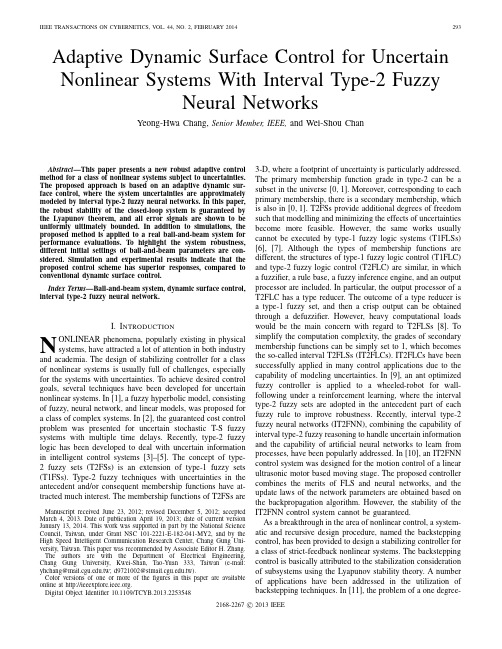
Adaptive Dynamic Surface Control for Uncertain Nonlinear Systems With Interval Type-2FuzzyNeural NetworksYeong-Hwa Chang,Senior Member,IEEE,and Wei-Shou ChanAbstract—This paper presents a new robust adaptive control method for a class of nonlinear systems subject to uncertainties. The proposed approach is based on an adaptive dynamic sur-face control,where the system uncertainties are approximately modeled by interval type-2fuzzy neural networks.In this paper, the robust stability of the closed-loop system is guaranteed by the Lyapunov theorem,and all error signals are shown to be uniformly ultimately bounded.In addition to simulations,the proposed method is applied to a real ball-and-beam system for performance evaluations.To highlight the system robustness, different initial settings of ball-and-beam parameters are con-sidered.Simulation and experimental results indicate that the proposed control scheme has superior responses,compared to conventional dynamic surface control.Index Terms—Ball-and-beam system,dynamic surface control, interval type-2fuzzy neural network.I.IntroductionN ONLINEAR phenomena,popularly existing in physical systems,have attracted a lot of attention in both industry and academia.The design of stabilizing controller for a class of nonlinear systems is usually full of challenges,especially for the systems with uncertainties.To achieve desired control goals,several techniques have been developed for uncertain nonlinear systems.In[1],a fuzzy hyperbolic model,consisting of fuzzy,neural network,and linear models,was proposed for a class of complex systems.In[2],the guaranteed cost control problem was presented for uncertain stochastic T-S fuzzy systems with multiple time delays.Recently,type-2fuzzy logic has been developed to deal with uncertain information in intelligent control systems[3]–[5].The concept of type-2fuzzy sets(T2FSs)is an extension of type-1fuzzy sets (T1FSs).Type-2fuzzy techniques with uncertainties in the antecedent and/or consequent membership functions have at-tracted much interest.The membership functions of T2FSs are Manuscript received June23,2012;revised December5,2012;accepted March4,2013.Date of publication April19,2013;date of current version January13,2014.This work was supported in part by the National Science Council,Taiwan,under Grant NSC101-2221-E-182-041-MY2,and by the High Speed Intelligent Communication Research Center,Chang Gung Uni-versity,Taiwan.This paper was recommended by Associate Editor H.Zhang. The authors are with the Department of Electrical Engineering, Chang Gung University,Kwei-Shan,Tao-Yuan333,Taiwan(e-mail: yhchang@.tw;d9721002@.tw).Color versions of one or more of thefigures in this paper are available online at .Digital Object Identifier10.1109/TCYB.2013.22535483-D,where a footprint of uncertainty is particularly addressed. The primary membership function grade in type-2can be a subset in the universe[0,1].Moreover,corresponding to each primary membership,there is a secondary membership,which is also in[0,1].T2FSs provide additional degrees of freedom such that modelling and minimizing the effects of uncertainties become more feasible.However,the same works usually cannot be executed by type-1fuzzy logic systems(T1FLSs) [6],[7].Although the types of membership functions are different,the structures of type-1fuzzy logic control(T1FLC) and type-2fuzzy logic control(T2FLC)are similar,in which a fuzzifier,a rule base,a fuzzy inference engine,and an output processor are included.In particular,the output processor of a T2FLC has a type reducer.The outcome of a type reducer is a type-1fuzzy set,and then a crisp output can be obtained through a defuzzifier.However,heavy computational loads would be the main concern with regard to T2FLSs[8].To simplify the computation complexity,the grades of secondary membership functions can be simply set to1,which becomes the so-called interval T2FLSs(IT2FLCs).IT2FLCs have been successfully applied in many control applications due to the capability of modeling uncertainties.In[9],an ant optimized fuzzy controller is applied to a wheeled-robot for wall-following under a reinforcement learning,where the interval type-2fuzzy sets are adopted in the antecedent part of each fuzzy rule to improve robustness.Recently,interval type-2 fuzzy neural networks(IT2FNN),combining the capability of interval type-2fuzzy reasoning to handle uncertain information and the capability of artificial neural networks to learn from processes,have been popularly addressed.In[10],an IT2FNN control system was designed for the motion control of a linear ultrasonic motor based moving stage.The proposed controller combines the merits of FLS and neural networks,and the update laws of the network parameters are obtained based on the backpropagation algorithm.However,the stability of the IT2FNN control system cannot be guaranteed.As a breakthrough in the area of nonlinear control,a system-atic and recursive design procedure,named the backstepping control,has been provided to design a stabilizing controller for a class of strict-feedback nonlinear systems.The backstepping control is basically attributed to the stabilization consideration of subsystems using the Lyapunov stability theory.A number of applications have been addressed in the utilization of backstepping techniques.In[11],the problem of a one degree-2168-2267c 2013IEEEFig.1.Structure of IT2FNN.of-freedom master-slave teleoperated device was discussed by the adaptive backstepping haptic control approach.The adaptive backstepping control was also applied to a plane-type 3-DOF precision positioning table,in which the unmodeled nonlinear effects and parameter uncertainties were considered [12].In[13],a backstepping controller design was investigated for the maneuvering of helicopters to autonomously track predefined trajectories.In[14],a voltage-controlled active magnetic bearing system was addressed,where a robust con-troller was designed to overcome unmodeled dynamics and parametric uncertainties by backstepping techniques.In[15], a backstepping oriented nonlinear controller was proposed to improve the shift quality of vehicles with clutch-to-clutch gearshifts.In[16],theflocking of multiple nonholonomic wheeled robots was studied,where distributed controllers were proposed with the backstepping techniques,graph theory and singular perturbation theory.The position control of a highly-nonlinear electrohydraulic system was considered,where an indirect adaptive backstepping was utilized to deal with param-eter variations[17].In[18],a neural network and backstepping output feedback controller was proposed for leader-follower-based multirobot formation control.In[19],an adaptive back-stepping approach was presented for the trajectory tracking problem of a closed-chain robot,where radial basis function neural networks were used to compensate complicated non-linear terms.In[20],an adaptive neural network backstepping output-feedback control was presented for a class of uncertain stochastic nonlinear strict-feedback systems with time-vary delays.Although backstepping control can be applied to a wide range of systems,however,there is a substantial drawback of the explosion of terms with conventional backstepping techniques.The dynamic surface control(DSC)has been proposed to overcome the“explosion of terms"problem, caused by repeated differentiations.Similar to the backstep-ping approach,DSC is also an iteratively systematic design procedure.The complexity arisen from the explosion terms in conventional backstepping control methods can be avoided by introducingfirst-order low passfilters[21]–[23].In[24], an integrator-backstepping-based DSC method for a two-axis piezoelectric micropositioning stage was proposed,where the robustness of tracking performance can be improved.In[25],a feedback linearization strategy including the dynamic surface control was developed to improve paper handling performance subject to noises.In[26]and[27],an adaptive DSC was adopted for mobile robots,where the exact parameters of robot kinematics and dynamics including actuator dynamics were assumed to be unknown a priori.In[28],a T-S fuzzy model based adaptive DSC was proposed for the balance control of a ball-and-beam system.Based on the T-S fuzzy modelling,the dynamic model of the ball-and-beam system was formulated as a strict feedback form with modelling errors.An observer-based adaptive robust controller was developed via DSC tech-niques for the purpose of achieving high-performance for servo mechanisms with unmeasurable states[29].A robust adaptive DSC approach was presented for a class of strict-feedback single-input-single-output nonlinear systems,where radial-basis-function neural networks were used to approximate those unknown system functions[30],[31].In[32],a novel-function approximator was constructed by combining a fuzzy-logic system with a Fourier series expansion to approximate the un-known system function depending nonlinearly on the periodic disturbances.Based on this approximator,an adaptive DSC was proposed for strict-feedback and periodically time-varyingCHANG AND CHAN:ADAPTIVE DYNAMIC SURFACE CONTROL FOR UNCERTAIN NONLINEAR SYSTEMS295systems with unknown control-gain functions.In[33]and [34],an adaptive fuzzy backstepping dynamic surface control approach was developed for a class of multiple-input multiple-output nonlinear systems and uncertain stochastic nonlinear strict-feedback systems,respectively.In[35],an adaptive DSC was proposed for a class of stochastic nonlinear systems with the standard output-feedback form,where neural networks were used to approximate the unknown system functions. In[36],a neural-network-based decentralized adaptive DSC control design method was proposed for a class of large-scale stochastic nonlinear systems,where neural network method was used to approximate the unknown nonlinear functions. In this paper,a robust adaptive control method is presented for a class of uncertain nonlinear systems.The proposed con-trol scheme is based on adaptive DSC techniques combining with IT2FNN learning(IT2FNNADSC).To achieve a desired tracking goal,a stabilizing control action can be systematically derived.Also,the uncertainty modelling can be attained using IT2FNNs.The IT2FNN has the ability to accurately approxi-mate nonlinear systems or functions with uncertainties based on the merits of both the type-2fuzzy logic and the neural network.From the Lyapunov stability theorem,it is shown that the closed-loop system is stable,and all error signals are uniformly ultimately bounded.In addition,a ball-and-beam system is utilized for performance validations,including both simulation and experimental results.Moreover,the form of strict-feedback systems is a special case of addressed general nonlinear systems.Thus,the proposed IT2FNNADSC control method can be easily applied to many applications of interest. The organization of this paper is as follows.In Section II, the dynamic characteristics of uncertain nonlinear systems are discussed.The structure and design philosophy of IT2FNNs and the design procedures of the adaptive DSC were intro-duced in Section III.The stability analysis is investigated in Section IV.In Section V,a ball-and-beam system is applied for performance validations,where both simulation and ex-perimental results are included.The concluding remarks are given in Section VI.II.PreliminariesA.Problem FormulationConsider a class of nonlinear systems as follows.˙x1=f1(x)+g1(x1)x2˙x2=f2(x)+g2(x1,x2)x3...˙x i=f i(x)+g i(x1,x2,...,x i)x i+1...˙x n=f n(x)+g n(x)u(t)(1)where i=1,2,...,n−1,x=[x1x2···x n]T∈R n is the state vector,u(t)∈R is the control input.The f i,g i, i=1,2,...,n are smooth system and virtual control-gain functions,respectively.In this paper,the state vector x is assumed to be in a compact set in R n.Definition1:System(1)is uniformly ultimately bounded with ultimate bound b if there exist positive constants band Fig.2.Interval type-2membership function with an uncertain mean. c,independent of t0≥0,and for every a∈(0,c),there is T=T(a,b)≥0,independent of t0such that[37]x(t0) ≤a⇒ x(t) ≤b,∀t≥t0+T.(2) With the consideration of system uncertainties,the perturbed model of(1)can be represented in˙x1=f1(x)+g1(x1)x2+ 1(x,t)˙x2=f2(x)+g2(x1,x2)x3+ 2(x,t)...˙x i=f i(x)+g i(x1,x2,...,x i)x i+1+ i(x,t)...˙x n=f n(x)+g n(x)u(t)+ n(x,t)(3)where i=1,2,...,n−1.The i(x,t),i=1,2,...,n are bounded uncertainties,consisting of unknown modelling errors,parameter uncertainties,and/or external disturbances. Denote x1d(t)as a control goal of x1(t).The control objective is to develop an adaptive controller such that the corresponding closed-loop system of(3)is stable,all errors are uniformly ultimately bounded,and the magnitude of the tracking error x1(t)−x1d(t)can be arbitrary small as t→∞. Assumption1:There exist some constantsγi>0,ψi>0, i=1,2,...,n such thatψi≤ g i(x1,x2,...,x i) ≤γi.(4) Assumption2:The reference command x1d(t)is a continu-ous and bounded function of degree2such that x1d,˙x1d,and ¨x1d are well defined.Remark1:In particular casesf i(x)=f i(x1,x2,...,x i),i=1,2,...,n(5) the representation of(1)turns out to be a class of nonlinear systems with a general strict-feedback form.B.Interval Type-2Fuzzy Neural NetworksRecently,interval type-2fuzzy neural networks handling uncertainty problems have been popularly addressed.The design procedures of IT2FNNs will be introduced in this section.First,the IF-THEN rules for an IT2FNN can be expressed asR j:IF x(1)1is˜F1j AND···AND x(1)n is˜F njTHEN y(5)is[w(4)jL w(4)jR],j=1,2,...,m(6)296IEEE TRANSACTIONS ON CYBERNETICS,VOL.44,NO.2,FEBRUARY2014 where˜F ij is an interval type-2fuzzy set of the antecedentpart,[w(4)jL w(4)jR]is a weighting interval set of the consequentpart,and x(1)i is the input of IT2FNN,i=1,2,...,n.Thenetwork structure of IT2FNN is shown in Fig.1,in whichthe superscript is used to identify the layer number.Thefunctionality of each layer of the IT2FNN will be introducedin sequence.1)Input Layer:In this layer,x(1)1,...,x(1)n,denoted as thestate variables of(3),are the inputs of IT2FNN.2)Membership Layer:In this layer,each node performsits work as an interval type-2fuzzy membership function.Asshown in Fig.2,the associated Gaussian membership functionregarding the i th input and j th nodes is represented asμ(2)˜F ij (x(1)i)=exp⎛⎝−12x(1)i−m(2)ijσ(2)ij2⎞⎠≡N(m(2)ij,σ(2)ij,x(1)i)(7)where m(2)ij∈[m(2)ijL m(2)ijR]is an uncertain mean,andσ(2)ij is a variance,i=1,...,n,j=1,...,m.In Fig.2,the upper mem-bership function(UMF)and the lower membership function(LMF)are denoted as¯μ(2)˜F ij (x(1)i)andμ(2)˜F ij(x(1)i),respectively.The upper and lower bounds of each type-2Gaussian membership function can be respectively represented as¯μ(2)˜F ij (x(1)i)=⎧⎪⎨⎪⎩N(m(2)ijL,σ(2)ij,x(1)i),x(1)i<m(2)ijL1,m(2)ijL≤x(1)i≤m(2)ijRN(m(2)ijR,σ(2)ij,x(1)i),x(1)i>m(2)ijR,(8)μ(2)˜F ij (x(1)i)=⎧⎨⎩N(m(2)ijL,σ(2)ij,x(1)i),x(1)i>m(2)ijL+m(2)ijR2N(m(2)ijR,σ(2)ij,x(1)i),x(1)i≤m(2)ijL+m(2)ijR2.(9)Therefore,the outputs of membership layer can be describedas a collection of intervals[μ(2)˜F ij (x(1)i)¯μ(2)˜F ij(x(1)i)],i=1,...,n,j=1,...,m.3)Rule Layer:The operation of this layer is to multiply the input signals and output the result of product.For example, the output of the j th node in this layer is calculated as[f(3)j ¯f(3)j]=n i=1μ(2)˜F ij(x(1)i) n i=1¯μ(2)˜F ij(x(1)i).(10)4)Type-Reduction Layer:Type-reducer has been applied to reduce a type-2fuzzy set to a type-reduced set[6],[38]. This type-reduced set is then defuzzified to derive a crisp output.To simplify the computation complexity,singleton output fuzzy sets with the center-of-sets type reduction method are considered such that the output y(4)=[y(4)L y(4)R]is an interval type-1set.Then,the output of the type-reduction layercan be expressed asy(4)= mj=1f(3)j w(4)jmj=1f(3)j(11)where w(4)j=[w(4)jL w(4)jR]is consequent interval weighting andf(3)j=[f(3)j ¯f(3)j]is the interval degree offiring.Withoutloss of generality,w(4)jR and w(4)jL are assumed to be assigned in ascending order,i.e.,w(4)1L≤w(4)2L≤···≤w(4)mL and w(4)1R≤w(4)2R≤···≤w(4)mR.With reference to[39]and[40],the calculation of y(4)L and y(4)R can be derived asy(4)L=lj=1¯f(3)jw(4)jL+mj=l+1f(3)jw(4)jLj=1f j+j=l+1f(3)j,(12) y(4)R=rj=1f(3)jw(4)jR+mj=r+1¯f(3)jw(4)jRrj=1f(3)j+mj=r+1¯f(3)j.(13)Obviously,the numbers l and r in(12)and(13)are essential in the switching between the lowerfiring strength f(3)jand the upperfiring strength¯f(3)j.In general,the values of l and r can be obtained from a sorting process.In[9],a simplified type of reduction was proposed as follows:ˆy(4)L=mj=1f(3)jw(4)jLmj=1f(3)j≡W T L F(14)ˆy(4)R=mj=1¯f(3)jw(4)jRmj=1¯f(3)j≡W T R¯F(15)where W L and W R are the weighting vectors connected between the rule layer and type-reduction layer,W T L=w(4)1L w(4)2L···w(4)mL,W T R=w(4)1R w(4)2R···w(4)mR;F and¯F are the weightedfiring strength vectorF=f(3)1mj=1f(3)jf(3)2mj=1f(3)j···f(3)mmj=1f(3)jT,¯F=¯f(3)1mj=1¯f(3)j¯f(3)2mj=1¯f(3)j···¯f(3)mmj=1¯f(3)jT.It is noted that only the lower and upper extremefiring-strengths are used in(14)and(15),respectively,such that the computation burden can be reduced.5)Output Layer:The output y(5)is determined as the average ofˆy(4)L andˆy(4)Ry(5)=ˆy(4)L+ˆy(4)R2.(16) Remark2:The results obtained so far are mainly on the structure description of IT2FNNs.It is more interesting to investigate how to model the uncertain terms in(3)with IT2FNNs.Moreover,the closed-loop stability affected by the approximation errors will be addressed later on.III.Design of IT2FNNADSCIn this paper,the dynamic surface control method is utilized to design a stabilizing controller for a class of uncertain nonlinear systems of(3).With IT2FNNs,uncertainty terms of(3)can be approximately modeled asi(x,t)=12W T i F i+εi(17) where W T i=W T iL W T iRis an ideal constant weights vector, F i=F T i¯F T iTis thefiring strength vector,andεi is the approximation error,i=1,2,...,n.In(17),there exist some unknown bounded constants W M andεM such that W i ≤CHANG AND CHAN:ADAPTIVE DYNAMIC SURFACE CONTROL FOR UNCERTAIN NONLINEAR SYSTEMS297 W M and εi ≤εM,respectively.Since there is no a prioriknowledge to determine exact W i s,an adaptive mechanismis applied such that the estimatedˆW i can asymptoticallyconverge to W i.Let the estimation error be defined as follows:˜Wi(t)=ˆW i(t)−W i,i=1,2,...,n.(18)For the aforementioned uncertain nonlinear systems,an adap-tive dynamic surface control(ADSC)will be proposed topreserve the closed-loop stability.The design procedures re-garding the ADSC are discussed in the following.To stayconcise,the notations i,i=1,2,...,n,will be used torepresent the uncertainties of(3).Step3.1:Defines1=x1−x1d.(19)It is desired to track the reference command x1d with giveninitial conditions.From(3)and(17),the derivative of(19)canbe obtained as˙s1=f1+g1x2+12W T1F1+ε1−˙x1d.(20)Let¯x2be a stabilizing function to be determined for(3)¯x2=g−11(−f1−12ˆW T1F1−k1s1+˙x1d)(21)where k1is a positive constant.An adaptive law is designated as˙ˆW 1=121F1s1−η 1ˆW1(22)with a symmetric positive definite matrix 1andη>0.Let x2d be the regulated output of¯x2through a low-passfilter τ2˙x2d(t)+x2d(t)=¯x2,x2d(0)=¯x2(0).(23) With a properly chosenτ2,the smoothed x2d can be equiva-lently considered the required¯x2.Step3.2:Analogous to the discussion in Step3.1,an error variable is defined ass2=x2−x2d.(24) From(3)and(17),the derivative of(24)can be obtained as ˙s2=f2+g2x3+12W T2F2+ε2−˙x2d.(25) Let¯x3be a stabilizing function to be determined for(3)¯x3=g−12(−f2−12ˆW T2F2−k2s2+˙x2d)(26)where k2is a positive constant.An adaptation law is designed as˙ˆW 2=122F2s2−η 2ˆW2(27)with a symmetric positive definite matrix 2.Let x3d be the smoothed variable of¯x3through a low-passfilterτ3˙x3d(t)+x3d(t)=¯x3,x3d(0)=¯x3(0).(28) With a properly chosenτ3,the smoothed x3d can be equiva-lently considered the required¯x3.Step3.i:The state tracking error of x i is defined ass i=x i−x id.(29) From(3)and(17),the derivative of(29)can be obtained as˙s i=f i+g i x i+1+12W T i F i+εi−˙x id.(30) Let¯x i+1be a stabilizing function to be determined for(3)¯x i+1=g−1i(−f i−12ˆW T i F i−k i s i+˙x id)(31) where k i is a positive constant.Similarly,an adaptive law is given as˙ˆWi=12i F i s i−η iˆW i(32) with a positive definite matrix i= T i.Similarly,let x i+1,d be the smoothed counterpart of¯x i+1through a low-passfilter τi+1˙x i+1,d(t)+x i+1,d(t)=¯x i+1,x i+1,d(0)=¯x i+1(0).(33) With a properly chosenτi+1,d,the smoothed x i+1,d can be equivalently considered the required¯x i+1.Step3.n:The state tracking error of x n is defined ass n=x n−x nd.(34) From(3)and(17),the derivative of(34)can be obtained as˙s n=f n+g n u(t)+12W T n F n+εn−˙x nd.(35) Let u(t)be a stabilizing function to be determined for(3) u(t)=g−1n(−f n−12ˆW T n F n−k n s n+˙x nd)(36) where k n is a positive constant.Analogous to the aforemen-tioned discussion,an adaptive law is given as˙ˆWn=12n F n s n−η nˆW n(37) where n is a symmetric matrix, n>0.Remark3:So far,only the design procedures,combining DSC approach and IT2FNN,are identified step by step.The derivation of control actions and learning rules in each step will be investigated later,where the closed-loop stability will also be discussed in detail.IV.Stability AnalysisIn this section,the overall stability of a class of uncertain nonlinear systems will be investigated,where a DSC controller with an IT2FNN adaption is adopted.In this paper,let 0and n be feasible sets of IT2FNNADSC such that0={(x1d,˙x1d,¨x1d):x1d+˙x1d+¨x1d≤p0}(38)n=(s i,˜W i,h i):12ni=1s2i+˜W T i −1i˜W i+12ni=2h2i≤p(39)where p0and p are positive constants.It is noticed that 0 and n are compact sets in R3and R(2m+2)n−1.298IEEE TRANSACTIONS ON CYBERNETICS,VOL.44,NO.2,FEBRUARY 2014Theorem 1:Consider a class of uncertain nonlinear systems of (3).With the DSC controller and IT2FNN adaptive laws designed as (19),(21)–(24),(26)–(29),(31)–(34),(36)–(37),the corresponding s i and ˜Wi are uniformly ultimately bounded,i =1,2,...,n ,where (38)and (39)are satisfied.Proo f :First,the errors between the stabilizing variables and the smoothed variables are defined ash i +1=x i +1,d −¯x i +1=x i +1,d −g −1i (−f i −12ˆW Ti F i −k i s i +˙x id )(40)where i =1,2,...,n −1.From (30),(31),and (40),the derivative of s i can be derived as˙s i=g i s i +1+g i h i +1−12˜W Ti F i +εi −k i s i(41)in which i =1,2,...,n −1.From (35)and (36),the derivativeof the tracking error s n can be obtained as˙s n =−k n s n −12˜W Tn F n +εn .(42)From (33)and (40),the dynamics of the smoothed variablex id can be formulated as˙x id (t )=¯x i −x id τi =−h iτi,i =2,3,...,n.(43)Therefore,from (40)and (43),the dynamic changes of h i +1can be derived in the following:˙h i +1=˙x i +1,d −˙¯x i +1=−h i +1τi +1+B i +1,i =1,2,...,n −1(44)in whichB i +1(s 1,...,s n ,h 2,...,h n ,ˆW T 1,...,ˆW T i ,x 1d ,˙x 1d ,¨x 1d )=g −2i [(˙f i +12˙ˆW T i F i +12ˆW T i ˙F i +k i ˙s i+˙h i τi )g i −˙g i (f i +12ˆW TiF i −˙x id +k i s i )].Choose a Lyapunov function candidate asV =12 n i =1 s 2i +˜W T i −1i ˜W i +12 n i =2h 2i .(45)The derivative of (45)can be obtained as˙V = n i =1 s i ˙s i +˜W T i −1i ˙ˆW i + n i =2h i ˙h i .(46)From (41),(42),(44),and (46),it leads to ˙V≤s 1(g 1s 2+g 1h 2−12˜W T1F 1+ε1−k 1s 1)+s 2(g 2s 3+g 2h 3−12˜W T2F 2+ε2−k 2s 2)+···+s i (g i s i +1−12˜W Ti F i +g i h i +1+εi −k i s i )+···+s n (−k n s n −12˜W Tn F n +εn )+ n i =1˜W T i −1i ˙ˆW i + n i =2 −h 2i τi + h i B i.(47)It is true thats i s i +1≤s 2i +s 2i +1,s i h i +1≤s 2i +h 2i +1,i =1,2,...,n −1(48)ands i εi ≤s 2i +ε2i ,i =1,2,...,n.(49)Therefore,the following inequality can be obtained by substi-tuting (4),(22),(27),(32),(37),and (48),(49)into (47)˙V ≤ n −1i =1(2γi s 2i +γi s 2i +1+γi h 2i +1)+ n i =1(−k i s 2i +ε2i +s 2i )+ n i =1(−η˜W T i ˆW i )+ n i =2 −h 2i τi+ h i B i .(50)Let α0>0be a constant such that k 1=2γ1+1+α0,k n =γn −1+1+α0,and k i =2γi +γi −1+1+α0,i =2,3,...,n −1,are satisfied.With reference to [30],using ˜Wi 2− W i 2≤2˜WT i ˆW i ,it gives ˙V ≤ ni =1(−α0s 2i +ε2i )+ n −1i =1(γi h 2i +1)+ n i =2 −h 2iτi + h i B i− n i =112η˜W i 2− W i 2 ≤ n i =1 −α0s 2i −η2λmax ( −1i )˜W T i −1i ˜W i+ n −1i =1(γi h 2i +1)+ n i =2 −h 2i τi + h i B i+ n i =1 ε2i +η2 W i 2.(51)Denoted ε2i +η2 W i 2=c i ,it leads to c i ≤ε2M +η2W 2M =c M ,i =1,2,...,n .From the positive definiteness of i ,a positive ηcan be determined such that η2λmax ( −1i)≥α0.From (51),itresults in˙V ≤ n i =1 −α0 s 2i +˜W T i −1i ˜W i +nc M + n −1i =1(γi h 2i +1)+ n i =2 −h 2iτi+ h i B i .(52)Therefore,from the assumptions of boundedness,smoothness,and compactness,B i is bounded on 0× n ,i.e.,there exists an M i >0such that B i ≤M i .Let1τi =γi −1+M 2i 2β+α0,i =2,3,...,n (53)where βis a positive number.Substituting (53)into (52),the following inequality can be obtained:˙V ≤ n i =1 −α0 s 2i +˜W T i −1i ˜W i +nc M + n i =2 − M 2i2β+α0 h 2i+ h i B i .(54)Notice that h i B i ≤h 2i B 2i 2β+ β2,i =2,3,...,n .Then,one can have˙V ≤ n i =1 −α0 s 2i +˜W T i −1i ˜W i +nc M +(n −1)β2+ n i =2 −α0h 2i −(M 2i −B 2i )h 2i 2β ≤ n i =1−α0 s 2i +˜W T i −1i ˜W i − n i =2(α0h 2i )+nc M +(n −1)β2=−2α0V +nc M +(n −1)β2.(55)Solving (55)leads toV (t )≤12α0 nc M +(n −1)β2+ V (0)−12α0nc M +(n −1)β2e (−2α0t ),∀t >0.(56)CHANG AND CHAN:ADAPTIVE DYNAMIC SURFACE CONTROL FOR UNCERTAIN NONLINEAR SYSTEMS299Fig.3.Experiment setup of the ball-and-beam system.From (56),it can be observed that V (t )is uniformly ultimately bounded,and the proof is completed.ٗRemark 4:By increasing the value of α0,the quantity of12α0(nc M +(n −1)β2)can be made arbitrarily small.Also,the convergence of V (t )implies that s i ,˜Wi ,and h i are uniformly ultimately bounded.Thus a large enough α0can make s 1=x 1−x 1d arbitrarily small.Equivalently,the stability of the proposed IT2FNNADSC control system can be guaranteed,and the purpose of tracking can be achieved in the boundness of steady-state errors.V .Example:Ball-and-Beam SystemTo verify the feasibility of the proposed IT2FNNADSC,anend-point driven ball-and-beam system is considered,where the scheme diagram is shown in Fig.3,and the associated dynamic equations are described as follows [41]:˙x 1=x 2+ 1(x ,t )˙x 2=Ax 1x 24−Agx 3+ 2(x ,t )˙x 3=x 4+ 3(x ,t )˙x 4=B cos x 3[C cos l b x 3d u −Dx 4cos l b x 3d−E −Hx 1]−BGx 1x 2x 4+ 4(x ,t )(57)where x (t )=[x 1(t )x 2(t )x 3(t )x 4(t )]T is the state vector,x 1is the ball position (m),x 2is the ball velocity (m/sec),x 3is the beam angle (rad),x 4is the angular velocity of the beam(rad/sec),A = 1+m −1B J B R −2 −1,B = J B +J b +m B x 21 −1,C =n g K b l b (R a d )−1,D = n g K b l b 2 R a d 2 −1,E =0.5l b m b g ,H =m B g ,G =2m B ,and u (t )is the input voltage of a DC motor.The physical parameters of the ball-and-beam system are listed in Table I.Remark 5:The representation of (57)can be fitted into the general form of (3).In consequence,the proposed IT2FNNADSC will be applied for the position control of a ball-and-beam system,where the ball is desired to be asymptotically balanced at a designated position.TABLE IParameters of the Ball-and-Beam System Symbol DefinitionValue m B Mass of the ball 0.0217kg m b Mass of the beam 0.334kg R Radius of the ball 0.00873m l b Beam length0.4m d Radius of the large gear 0.04mJ B Ball inertia 6.803×10−7kgm 2J b Beam inertia0.017813kgm 2K b Back-EMF constant 0.1491Nm/A R a Armature resistance 18.91 g Acceleration of gravity 9.8m /s 2n gGear ratio4.2TABLE IIParameters of ADSCi 1234k i 2840.887434.943727τi N/A0.0250.0250.025 i 100I 32α025η0.5A.Simulation ResultsFrom (21),(26),(31),and (57),stabilizing functions can be obtained as follows:¯x 2=−12ˆW T1F 1−k 1s 1+˙x 1d(58)¯x 3=−1Ag −12ˆW T 2F 2−k 2s 2−Ax 1x 24+˙x 2d (59)and¯x 4=−12ˆWT3F 3−k 3s 3+˙x 3d (60)where the employing neural networks are adaptively obtained from (32).From (36)and (57),the IT2FNNADSC based control action can be drived asu (t )=1BC cos x 3cos l b x 3d·[B cos x 3(Dx 4cos l b x 3d +E +Hx 1)+BGx 1x 2x 4+˙x4d −k 4s 4−12ˆW T4F 4].(61)The parameters for the conventional DSC and the IT2FNNADSC are initially given in Tables II and III,in which F 1=F 2=F 3=F 4=⎡⎣f (3)1 16j =1f (3)j···f (3)16 16j =1f (3)j¯f (3)1 16j =1¯f (3)j ···¯f (3)16 16j =1¯f(3)j ⎤⎦T ,[f (3)j¯f (3)j ]=[ 4i =1μ(2)˜F ij 4i =1¯μ(2)˜F ij ],j =1,2,...,16,and ˆW 1(0)=ˆW 2(0)=ˆW 3(0)=ˆW 4(0)=[ˆw(4)1L (0)···ˆw (4)16L (0)ˆw (4)1R (0)···ˆw (4)16R (0)]T .The rule table of an IT2FNN is shown in Table IV,where PS (positive small),PB (positive big),Neg (negative),Pos (positive),and Zero are interval type-2fuzzy sets.The input and output membership functions for the corresponding interval type-2fuzzy sets are shown in Fig.4.。
Observer-based adaptive fuzzy backstepping dynamic surface control for a class of non-linear ....
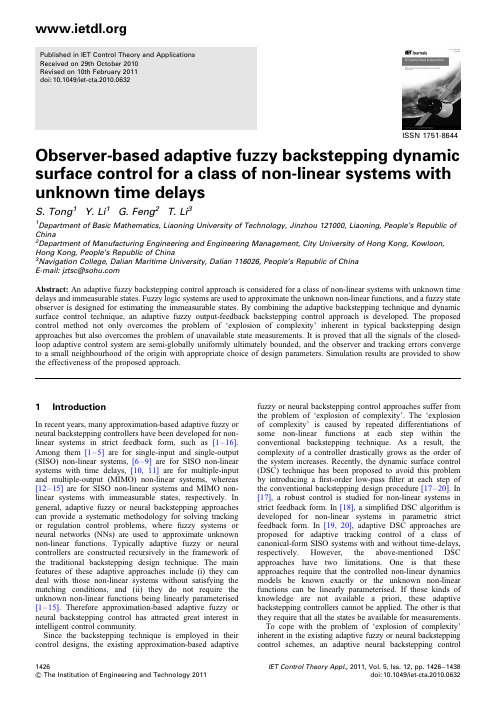
Published in IET Control Theory and Applications Received on 29th October 2010 Revised on 10th February 2011 doi: 10.1049/iet-cta.2010.0632
1426 & The Institution of Engineering and Technology 2011
fuzzy or neural backstepping control approaches suffer from the problem of ‘explosion of complexity’. The ‘explosion of complexity’ is caused by repeated differentiations of some non-linear functions at each step within the conventional backstepping technique. As a result, the complexity of a controller drastically grows as the order of the system increases. Recently, the dynamic surface control (DSC) technique has been proposed to avoid this problem by introducing a first-order low-pass filter at each step of the conventional backstepping design procedure [17 – 20]. In [17], a robust control is studied for non-linear systems in strict feedback form. In [18], a simplified DSC algorithm is developed for non-linear systems in parametric strict feedback form. In [19, 20], adaptive DSC approaches are proposed for adaptive tracking control of a class of canonical-form SISO systems with and without time-delays, respectively. However, the above-mentioned DSC approaches have two limitations. One is that these approaches require that the controlled non-linear dynamics models be known exactly or the unknown non-linear functions can be linearly parameterised. If those kinds of knowledge are not available a priori, these adaptive backstepping controllers cannot be applied. The other is that they require that all the states be available for measurements. To cope with the problem of ‘explosion of complexity’ inherent in the existing adaptive fuzzy or neural backstepping control schemes, an adaptive neural backstepping control
chen2015-自适应-扰动观测器

Abstract—In this paper, an adaptive neural output feedback control scheme is proposed for uncertain nonlinear systems that are subject to unknown hysteresis, external disturbances and unmeasured states. To deal with the unknown nonlinear function term in the uncertain nonlinear system, the approximation capability of the radial basis function neural network (RBFNN) is employed. Using the approximation output of the RBFNN, the state observer and the nonlinear disturbance observer (NDO) are developed to estimate unmeasured states and unknown compounded disturbances, respectively. Based on the RBFNN, the developed NDO and the state observer, an adaptive neural output feedback control is proposed for uncertain nonlinear systems using the backstepping technique. The first order sliding mode differentiator is employed to avoid the tedious analytic computation and the problem of “explosion of complexity” in the conventional backstepping method. The stability of the whole closed-loop system is rigorously proved via Lyapunov analysis method and the satisfactory tracking performance is guaranteed under the integrated effect of unknown hysteresis, unmeasured states and unknown external disturbances. Simulation results of an example are presented to illustrate the effectiveness of the proposed adaptive neural output feedback control scheme for uncertain nonlinear systems. Index Terms—Uncertain nonlinear system, Neural network, State observer, Disturbance observer, Output tracking control
Robust Control
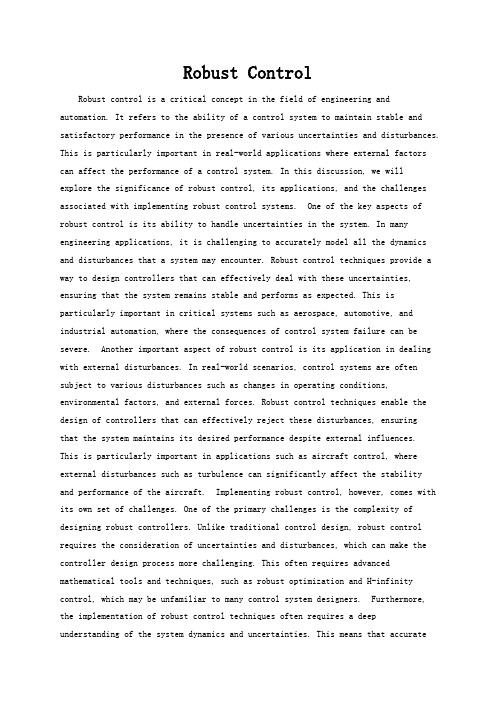
Robust ControlRobust control is a critical concept in the field of engineering and automation. It refers to the ability of a control system to maintain stable and satisfactory performance in the presence of various uncertainties and disturbances. This is particularly important in real-world applications where external factors can affect the performance of a control system. In this discussion, we willexplore the significance of robust control, its applications, and the challenges associated with implementing robust control systems. One of the key aspects of robust control is its ability to handle uncertainties in the system. In many engineering applications, it is challenging to accurately model all the dynamics and disturbances that a system may encounter. Robust control techniques provide a way to design controllers that can effectively deal with these uncertainties, ensuring that the system remains stable and performs as expected. This is particularly important in critical systems such as aerospace, automotive, and industrial automation, where the consequences of control system failure can be severe. Another important aspect of robust control is its application in dealing with external disturbances. In real-world scenarios, control systems are often subject to various disturbances such as changes in operating conditions, environmental factors, and external forces. Robust control techniques enable the design of controllers that can effectively reject these disturbances, ensuringthat the system maintains its desired performance despite external influences.This is particularly important in applications such as aircraft control, where external disturbances such as turbulence can significantly affect the stabilityand performance of the aircraft. Implementing robust control, however, comes with its own set of challenges. One of the primary challenges is the complexity of designing robust controllers. Unlike traditional control design, robust control requires the consideration of uncertainties and disturbances, which can make the controller design process more challenging. This often requires advanced mathematical tools and techniques, such as robust optimization and H-infinity control, which may be unfamiliar to many control system designers. Furthermore, the implementation of robust control techniques often requires a deep understanding of the system dynamics and uncertainties. This means that accuratemodeling of the system and its uncertainties is crucial for the successful implementation of robust control. In many real-world applications, obtaining accurate models of the system dynamics can be challenging, which can further complicate the design and implementation of robust control systems. Despite these challenges, the benefits of robust control are significant. By ensuring stability and performance in the presence of uncertainties and disturbances, robust control techniques can enhance the reliability and safety of critical systems. This is particularly important in applications such as autonomous vehicles, where the ability to maintain stable and predictable behavior in various operating conditions is crucial for ensuring the safety of passengers and pedestrians. In conclusion, robust control is a vital concept in the field of engineering and automation. Its ability to handle uncertainties and disturbances makes itessential for the design of reliable and high-performance control systems. While implementing robust control techniques comes with its challenges, the benefits it offers in terms of system reliability and safety make it a crucial area of research and development in the field of control systems. As technology continues to advance, the importance of robust control will only grow, ensuring thestability and performance of critical systems in the face of uncertainties and external disturbances.。
ADAPTIVE-ROBUST CONTROL OF THE STEWART-GOUGH PLATFORM AS A SIX DOF PARALLEL ROBOT

Keywords: Parallel robots, Stewart-Gough platform, adaptive-robust control scheme, Lagrangian dynamics.
1. INTRODUCTION
Parallel manipulators such as a Stewart-Gough platform, [1], have some advantages such as high force-to-weight ratio (high rigidity), compact size, capability for control with a very high bandwidth, their robustness against external forces and error accumulation, high dexterity and are suitable for an accurate positioning system. These manipulators have found a variety of applications in flight and vehicle simulators, high precision machining centers, mining machines, medical instruments, spatial devices, etc. However, they have some drawbacks of relatively small workspace and difficult forward kinematics problem. Generally, because of the nonlinearity and the complexity of the equations, forward kinematics of parallel manipulators is very complicated and difficult to solve. This is a contrast to serial manipulators. There are analytic solutions [2, 3 and 4], numerical ones [5] and solutions using the observers [6] for the forward kinematics problem of parallel robots. The analytical methods provide the exact solution; but, they are too complicated because the solution is obtained by solving the high-order polynomial equations. There is also the selection problem of the exact solution among the several ones. In fact there exists no general closed-form solution for the above problem. The Newton-Raphson method is known as a simple algorithm for solving nonlinear equations, whose convergence is good, but it takes much calculation time, and also it sometimes converges to the wrong solution according to the initial values. This method was used to solve the forward kinematic problem of platform-type robotic manipulators [5]. In the methods using the observers [6], two kinds of observers, linear and nonlinear, have been used. The linear observer is based on linearizing the nonlinear terms and leaves the steady-state error. The nonlinear observer has the difficulty to select the observation gains. A neural network based method may be applied to solve the forward kinematics problem as a basic element in the modeling and control of the parallel robots [7]. While the kinematics of parallel manipulators has been studied extensively during the last two decades, fewer contributions can be found on the dynamics problem of parallel mainpulators. Dynamical analysis of parallel robots, which is very important to develop a model-based controller, is complicated because of the existence of multiple closed-loop chains [8, 9]. Dynamic equations of a Stewart-Gough platform can be derived based on Lagrange' s formulation [10].
Robust Control
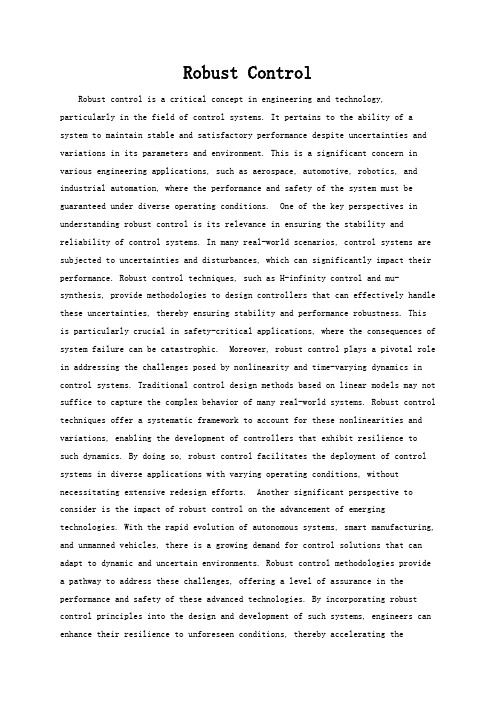
Robust ControlRobust control is a critical concept in engineering and technology,particularly in the field of control systems. It pertains to the ability of a system to maintain stable and satisfactory performance despite uncertainties and variations in its parameters and environment. This is a significant concern in various engineering applications, such as aerospace, automotive, robotics, and industrial automation, where the performance and safety of the system must be guaranteed under diverse operating conditions. One of the key perspectives in understanding robust control is its relevance in ensuring the stability and reliability of control systems. In many real-world scenarios, control systems are subjected to uncertainties and disturbances, which can significantly impact their performance. Robust control techniques, such as H-infinity control and mu-synthesis, provide methodologies to design controllers that can effectively handle these uncertainties, thereby ensuring stability and performance robustness. This is particularly crucial in safety-critical applications, where the consequences of system failure can be catastrophic. Moreover, robust control plays a pivotal role in addressing the challenges posed by nonlinearity and time-varying dynamics in control systems. Traditional control design methods based on linear models may not suffice to capture the complex behavior of many real-world systems. Robust control techniques offer a systematic framework to account for these nonlinearities and variations, enabling the development of controllers that exhibit resilience to such dynamics. By doing so, robust control facilitates the deployment of control systems in diverse applications with varying operating conditions, without necessitating extensive redesign efforts. Another significant perspective to consider is the impact of robust control on the advancement of emerging technologies. With the rapid evolution of autonomous systems, smart manufacturing, and unmanned vehicles, there is a growing demand for control solutions that can adapt to dynamic and uncertain environments. Robust control methodologies provide a pathway to address these challenges, offering a level of assurance in the performance and safety of these advanced technologies. By incorporating robust control principles into the design and development of such systems, engineers can enhance their resilience to unforeseen conditions, thereby accelerating thedeployment and adoption of these innovative technologies. Furthermore, the integration of robust control techniques with modern control paradigms, such as adaptive and learning-based control, presents an intriguing avenue for research and development. By combining the strengths of robust control in handling uncertainties with the capabilities of adaptive and learning-based approaches to adjust to changing environments, it is possible to create control systems that exhibit a high degree of flexibility and robustness. This convergence of methodologies holds promise in addressing complex control challenges in dynamic and uncertain environments, opening new possibilities for applications in fields such as healthcare, energy, and environmental monitoring. In conclusion, robust control stands as a cornerstone in the realm of control systems, offering indispensable tools and methodologies to address the challenges posed by uncertainties, variations, and nonlinearities. Its significance spans across diverse domains, from ensuring the stability and reliability of critical engineering systems to enabling the advancement of emerging technologies. As the landscape of engineering and technology continues to evolve, the role of robust control is poised to expand, driving innovation and resilience in the design and deployment of next-generation control systems.。
非线性系统的鲁棒H∞控制
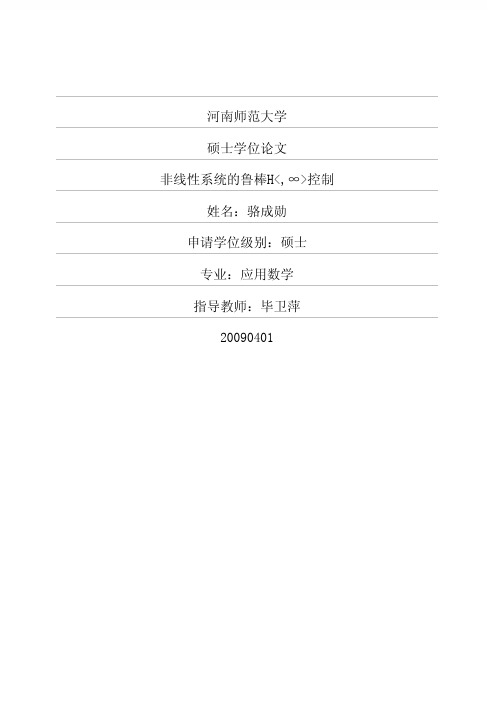
河南师范大学硕士学位论文非线性系统的鲁棒H<,∞>控制姓名:***申请学位级别:硕士专业:应用数学指导教师:***20090401摘要本文考虑了一类非线性时滞系统的鲁棒自适应巩控制和一类高阶非线性系统的鲁棒自适应比控制.在现有文献基础上,对非线性系统的鲁棒自适应如控制做了一些研究.首先,我们研究了一类非线性时滞系统的鲁棒自适应比控制,运用Backstepping方法和Lyapunov稳定性理论,通过巧妙的选取Lyapunov函数,构造了鲁棒自适应控制器,不仅解决了非线性系统中的时滞问题,并且保证了闭环系统的渐近稳定,数值例子和仿真证明了结论的有效性.其次,我们研究了一类高阶非线性系统的L2m增益鲁棒控制器设计方法,应用Back-stepping方法和改进的幂积分器方法,设计了一种新的鲁棒自适应如控制器,不仅使闭环系统全局渐近稳定并且满足上k范数界7.数值例子和仿真证明了结论的正确性.最后,针对以上非线性系统的鲁棒%控制问题作出了总结.关键词:鲁棒比控制,加幂积分器,自适应控制,渐近稳定ABSTRACTInthispaper,weconsidertheproblemofrobustadaptiveH∞controlforaclassofnonlineartime-delaysystemsandrobustadaptiveH∞controlforaclassofhigh-ordernonlinearsystems.Basedontheexistingliterature,somestudyhasbeendoneinthispaperonrobustadaptiveH∞controlofthenonlinearsystems.Firstly,WeconsidertheproblemofrobustadaptiveH∞controlforaclassofuncertainnonlineartime-delaysystems,usingBacksteppingmethodandLyapunovstabilitytheory,bychoosingLyapunovfunctionalskillfully,wehaveadesignofrobustadaptivecontroller.Wenotonlydealwiththetime—delaytermsofnonlinearsystems,butalsorendertheclosed—loopsystemasymptoticstability.Theillustrativeexampleandsimulationresultsverifytheeffectivenessoftheconclusion.Secondly,weconsiderthedesignmethodofL2仇一gainedrobustcontrollerforaclassofhigh—ordernonlinearsystems.Thesystemofthispaperisapolynomiallower—triangularform.BasedonBacksteppingmethodandmodifiedpowerintegratormethod,thenewrobustadaptive比controllerisdesigned,whichensuresthattheclosed—loopsystemismakes比normbound.Theillustrativeexampleandgloballyasymptoticallystableandsimulationresultsverifythecorrectnessoftheconclusion.Finally,wegiveasummaryoftheaboveproblemofrobustH∞controlfornonlinearsystems.KEYWORDS:RobustHoocontrol,PowerIntegrator,Adaptivecontrol,AsymptoticstabilityIII独创性声明本人郑重声明:所呈交的学位论文是我个人在导师指导下进行的研究工作及取得的研究成果.尽我所知,除了文中特别加以标注和致谢的地方外,论文中不包含其他人已经发表或撰写的研究成果,也不包含为获得河南师范大学或其他教育机构的学位或证书所使用过的材料.与我一同工作的同志对本研究所做的任何贡献均已在论文中作了明确的说明并表示了谢意.签名:脚日期.鲨Z:皇:型关于论文使用授权的说明本人完全了解河南师范大学有关保留、使用学位论文的规定,即:有权保留并向国家有关部门或机构送交论文的复印件和磁盘,允许论文被查阅和借阅.本人授权河南师范大学可以将学位论文的全部或部分内容编入有关数据库进行检索,可以采用影印、缩印或扫描等复制手段保存、汇编学位论文.(保密的学位论文在解密后适用本授权书)签名:第一章绪论§1.1学科概述在科技日新月异的今天,人们对实际生产过程的分析要求较高,大量的分析表明很多物理系统都是非线性的.严格地说,几乎所有的控制系统都是非线性的,非线性控制系统的形成基于两类原因,一是被控系统中包含有不能忽略的非线性因素,二是为提高控制性能或简化控制系统结构而人为地采用非线性元件.非线性系统的分析远比线性系统为复杂,缺乏能统一处理的有效数学工具.在许多工程应用中,由于难以求解出系统的精确输出过程,通常只限于考虑:系统是否稳定;系统是否产生自激振荡(见非线性振动)及其振幅和频率的测算方法;如何限制自激振荡的幅值以至消除它.而现代广泛应用于工程上的分析方法有基于频率域分析的描述函数法和波波夫超稳定性等,还有基于时间域分析的相平面法和李雅普诺夫稳定性理论等.这些方法分别在一定的假设条件下,能提供关于系统稳定性或过渡过程的信息.在某些工程问题中,非线性特性还常被用来改善控制系统的品质.例如将死区特性环节和微分环节同时加到某个二阶系统的反馈回路中去,就可以使系统的控制既快速又平稳.非线性控制系统在许多领域都具有广泛的应用.除了一般工程系统外,在机器人,生态系统和经济系统的控制中也具有重要意义.§1.2研究背景20世纪80年代以来,非线性科学越来越受到人们的重视,非线性系统的分析和设计问题引起了科研工作者的广泛兴趣【11.因为非线性系统所包含的现象十分复杂,迄今非线性系统理论还很不成熟.相平面法、李雅普诺夫方法和描述函数法是处理非线性控制系统的最经典的方法,但这三种分析方法对大多数非线性控制系统并不适用.变结构控制是目前最常用的非线性综合方法,并且已在实际中得到了一些应用,但使用该方法所设计的控制器会产生严重的抖动现象.各种智能方法也被用到非线性控制系统中,并提出了一些有效的控制方案.另一种研究非线性系统的思路是利用现代数学方法,其中的微分几何和微分代数控制方法极大地推动了非线性系统方面的研究.非线性系统的鲁棒比控制很多控制对象的数学模型随着时间或工作环境的改变而变化,其变化规律往往事先不知道.例如导弹或飞机的气动参数会随其飞行速度、飞机高度的变化而变化,因而导弹的数学模型参数可在很大的范围内变化.在飞行过程中,导弹的质量和质心位置会随着燃料的消耗而改变,这也会影响其数学模型的参数.当对象的数学模型参数在小范围内变化时,可用一般的反馈控制、最优控制或补偿控制等方法来消除或减小参数变化对控制品质的有害影响.如果控制对象参数在大范围内变化时,系统仍能自动地工作于最优工作状态或接近于最优的工作状态,因而就提出了自适应控制问题【2】.自适应控制是一种比较复杂的反馈控制,利用自适应控制能够解决一些常规的反馈控制所不能解决的复杂控制问题,可以大幅度地提高系统的稳态精度和动态品质.自从1983年Artstein[3】与Sontag[a]提出控制Lyapunov函数(CLF)概念后,借助于控制Lyapunov函数构造稳定控制律的方法得到了广泛的研究.对于某些类型的非线性系统,如果能找到其CLF,我们便能直接利用一些基于CLF与系统动态的通用公式【5'6】计算出使系统稳定的控制律.这样,Lyapunov函数不再局限于对非线性系统稳定性的描述,而在非线性控制系统的设计方面也显示出巨大的应用价值.近年来的研究已经使CLF进一步应用于时变系统、随机系统、离散系统等许多领域.Li与Kokotovic[71将CLF引入自适应非线性系统中,提出了自适应控制Lyapunov函数(ACLF)的概念,将对自适应系统的控制问题转化为对非自适应系统的控制问题.并利用ACLF构造控制律与自适应律.利用Lyapunov构造控制律具有较大的优势,因为即使我们通过其它方法构造出一个控制律,仍然需要一个适当的Lyapunov函数去证明其稳定性.Backstepping方法【5l是上世纪九十年代提出的,由于其独特的构造性的设计过程和对非匹配不确定的处理能力,在飞机及导弹控制系统设计中得到成功的应用.该方法是针对不确定性系统的一种系统化的控制器综合方法,是将Lyapunov函数的选取与控制器的设计相结合的一种回归设计方法.它通过从系统的最低阶次微分方程开始,引入虚拟控制的概念,一步一步设计满足要求的虚拟控制,最终设计出真正的控制律.时滞现象在各种各样的控制系统中都是普遍存在的,如长管道进料或皮带传输,极缓慢的过程或复杂的在线分析仪等均存在时滞现象.时滞的存在使得系统的分析和综合变得更加复杂和困难,因此,在过去的几十年内,不确定时滞系统的稳定性分析和镇定问题受到很多学者关注,并取得了丰硕成果【8—15】.在许多控制过程中,我们希望设计的控制器不仅要镇定整个闭环系统而且要实现系统第一章绪论满意的性能指标,其中的一种方法就是所谓的如控制.基于此种思想,如性能问题已取得了一些成果,见文献【16—29】.鲁棒上k控制理论是在上k空间(即Hardy空间)通过某些性能指标的无穷范数优化而获得具有鲁棒性能的控制器的一种理论.控制界将鲁棒日o。
H-无穷 控制
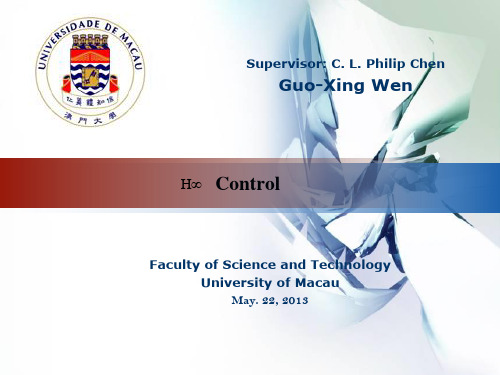
Robust Adaptive Neural Control for a Class of Perturbed Strict Feedback Nonlinear Systems
Step i:
Robust Adaptive Neural Control for a Class of Perturbed Strict Feedback Nonlinear Systems
H-infinity control question: Designing a desired controller so that the closed-loop system is stability and the transfer matrix can be minimized
Fundamental knowledge
The practical control law:
H-infinity tracking design in indirect adaptive fuzzy control
Finally, we have
H-infinity tracking design in indirect adaptive fuzzy control
Robust Adaptive Neural Control for a Class of Perturbed Strict Feedback Nonlinear Systems
Step n:
THE END
Q&A
23
Backstepping design: step 1:
Robust Adaptive Neural Control for a Class of Perturbed Strict Feedback Nonlinear Systems
Robust Control
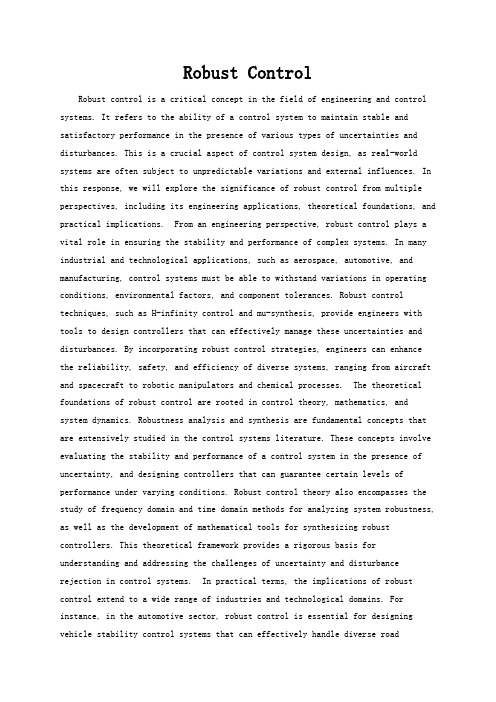
Robust ControlRobust control is a critical concept in the field of engineering and control systems. It refers to the ability of a control system to maintain stable and satisfactory performance in the presence of various types of uncertainties and disturbances. This is a crucial aspect of control system design, as real-world systems are often subject to unpredictable variations and external influences. In this response, we will explore the significance of robust control from multiple perspectives, including its engineering applications, theoretical foundations, and practical implications. From an engineering perspective, robust control plays a vital role in ensuring the stability and performance of complex systems. In many industrial and technological applications, such as aerospace, automotive, and manufacturing, control systems must be able to withstand variations in operating conditions, environmental factors, and component tolerances. Robust control techniques, such as H-infinity control and mu-synthesis, provide engineers with tools to design controllers that can effectively manage these uncertainties and disturbances. By incorporating robust control strategies, engineers can enhance the reliability, safety, and efficiency of diverse systems, ranging from aircraft and spacecraft to robotic manipulators and chemical processes. The theoretical foundations of robust control are rooted in control theory, mathematics, and system dynamics. Robustness analysis and synthesis are fundamental concepts that are extensively studied in the control systems literature. These concepts involve evaluating the stability and performance of a control system in the presence of uncertainty, and designing controllers that can guarantee certain levels of performance under varying conditions. Robust control theory also encompasses the study of frequency domain and time domain methods for analyzing system robustness, as well as the development of mathematical tools for synthesizing robust controllers. This theoretical framework provides a rigorous basis for understanding and addressing the challenges of uncertainty and disturbance rejection in control systems. In practical terms, the implications of robust control extend to a wide range of industries and technological domains. For instance, in the automotive sector, robust control is essential for designing vehicle stability control systems that can effectively handle diverse roadconditions and driver inputs. In the field of renewable energy, robust control techniques are used to optimize the performance of wind turbines and solar power plants in the face of fluctuating environmental factors. Moreover, in biomedical engineering, robust control plays a crucial role in the design of medical devices and physiological systems that must operate reliably in the presence of biological variability and external perturbations. These examples illustrate how robust control principles are indispensable for addressing real-world engineering challenges across various domains. Beyond its technical aspects, robust control also embodies broader themes of resilience, adaptability, and risk management. The concept of robustness resonates with the human experience of navigating uncertainty and adversity. In the face of unexpected events and changing circumstances, individuals and organizations alike seek to cultivate robustness in their strategies and systems. This resilience-oriented mindset is reflected in the principles of robust control, which emphasize the importance of anticipating and mitigating potential sources of instability and performance degradation. By embracing robust control principles, engineers and decision-makers can foster a proactive approach to managing uncertainties and enhancing the overall robustness of their systems and processes. In conclusion, robust control is a multifaceted concept that holds significant relevance in engineering, control theory, and practical applications. Its role in ensuring the stability, performance, and resilience of complex systems cannot be overstated. By integrating robust control techniques into the design and operation of control systems, engineers can address the challenges of uncertainty and disturbance rejection, ultimately contributing to the advancement of diverse technological domains. Moreover, the principles of robust control resonate with broader themes of adaptability and risk management, underscoring its significance in the context of human endeavors to navigate and thrive in an ever-changing world.。
International Journal of System Control and Information Processing.
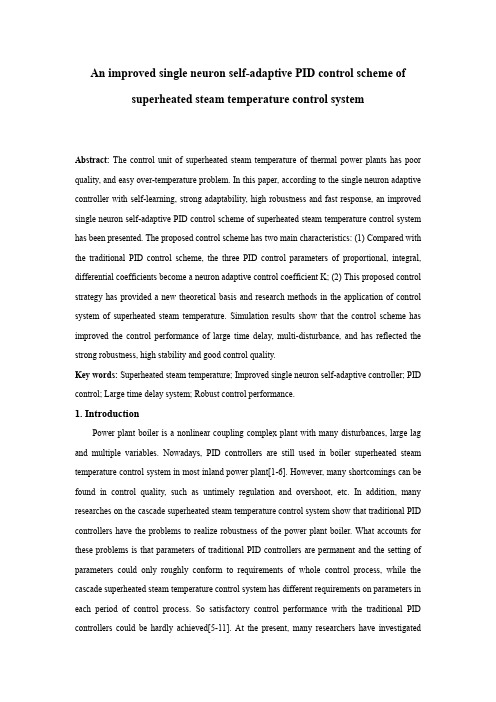
2. Modeling of Boiler Superheated Steam Temperature Plant
In this section, a coal-fired boiler (#2 furnace 600MW unit) in a certain thermal power plant is taken as an example to introduce the model structure chart of reconstructive boiler steam temperature system (Fig.1). The warm water reduction system of super heater uses two-level four-point cooling structure. First level desuperheater is arranged at two sides between low temperature superheater and dividing panel superheater; Second level desuperheater is arranged at two sides between rear platen superheater and steam lead pipe connected. Except the influence of swinging burner, two-level spray desuperheating adjustment is mainly applied in the main steam temperature control system.
An improved single neuron self-adaptive PID control scheme of superheated steam temperature control system
Transactions of the Institute of Measurement and Control-2013-Juan-1008-15
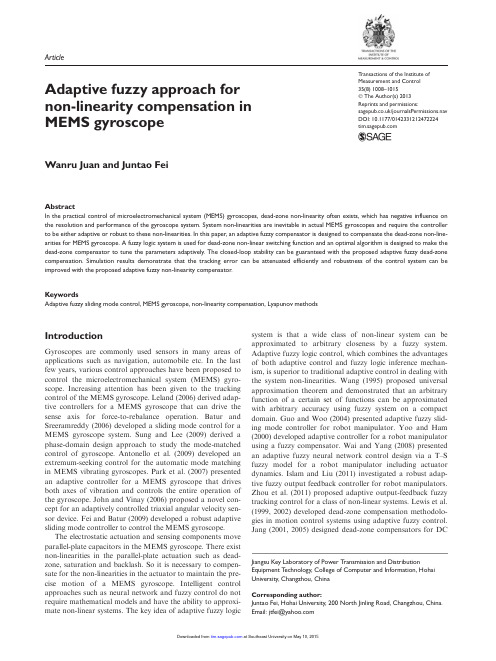
Adaptive fuzzy approach for non-linearity compensation in MEMS gyroscope
Wanru Juan and Juntao Fei
Transactions of the Institute of Measurement and Control 35(8) 1008–1015 Ó The Author(s) 2013 Reprints and permissions: /journalsPermissions.nav DOI: 10.1177/0142331212472224
Corresponding author: Juntao Fei, Hohai University, 200 North Jinling Road, Changzhou, China. Email: jtfei@
Downloaded from at Southeast University on May 10, 2015
Fei and Juan
1009
motor and an XY-Positioning Table using fuzzy logic control. Park and Han (2011) derived backstepping and recurrent fuzzy neural controller for a robot manipulator with deadzone and friction.
Jiangsu Key Laboratory of Power Transmission and Distribution Equipment Technology, College of Computer and Information, Hohai University, Changzhou, China
Robust Control

Robust ControlRobust control is a critical aspect of engineering and technology,particularly in the field of control systems. It refers to the ability of acontrol system to maintain stable and satisfactory performance in the presence of various uncertainties and disturbances. This is a crucial consideration in the design and implementation of control systems, as real-world systems are often subject to unpredictable variations and disturbances. In this response, I will explore the importance of robust control from various perspectives, including its significance in engineering, its impact on real-world applications, and the challenges and advancements in this field. From an engineering perspective, robust control is essential for ensuring the stability and performance of control systems in the face of uncertainties. In many engineering applications, such as aerospace, automotive, and manufacturing, control systems must operate reliably in diverse and unpredictable environments. For example, in the aerospace industry, aircraft control systems must be able to maintain stability and performance in the presence of varying weather conditions, turbulence, and other disturbances. Similarly, in the automotive industry, vehicle control systems must be robust enough to handle uncertainties such as road conditions, varying loads, and mechanical wear. In the field of manufacturing, control systems for industrial processes must be able to adapt to changes in operating conditions and disturbances to maintain productivity and quality. Robust control plays a crucial role in ensuring the safety, reliability, and efficiency of these engineering systems. In real-world applications, the importance of robust control becomes even more evident. Consider the example of autonomous vehicles, which rely on sophisticated control systems to navigate and operate safely in dynamic and unpredictable environments. These systems must be robust enough to handle uncertainties such as changes in road conditions, unpredictable behavior of other vehicles, and sensor noise. In the medical field, robust control is also crucial for the development of advanced medical devices and systems, such as robotic surgery systems and implantable medical devices. These systems must be able to operate reliably in the presence of uncertainties such as variations in patient anatomy, tissue properties, and physiological conditions. In all these real-worldapplications, robust control is essential for ensuring the safety, performance,and effectiveness of the systems. Despite its significance, achieving robust control is not without its challenges. One of the key challenges is the inherent complexity and nonlinearity of many real-world systems. Control systems must be able to handle these complexities and nonlinearities to maintain stability and performance in the presence of uncertainties. Another challenge is the limited availability of accurate and reliable models for many real-world systems. Control system design often relies on mathematical models of the system dynamics, which may not always capture all the uncertainties and variations present in the real system. Additionally, the design of robust control systems requires a deep understanding of the system dynamics and uncertainties, which can be a complex and time-consuming process. Despite these challenges, significant advancements have been made in the field of robust control, driven by developments in control theory, computational methods, and technological innovations. Advancements in control theory have led to the development of robust control techniques that caneffectively handle the complexities and uncertainties of real-world systems. For example, robust control methods such as H-infinity control and mu-synthesis have been developed to provide robust performance guarantees in the presence of uncertainties. These methods have been successfully applied to a wide range of engineering and technology applications, including aerospace, automotive, robotics, and process control. Computational methods have also played a crucial role in advancing robust control, enabling the design and implementation of complexcontrol systems with robust performance. For example, advances in computational tools and algorithms have made it possible to analyze and optimize the performance of control systems in the presence of uncertainties, leading to more reliable and efficient control solutions. Technological innovations, such as the development of advanced sensors, actuators, and communication systems, have also contributed to the advancement of robust control. These innovations have enabled the implementation of more sophisticated and adaptive control systems that can effectively handle uncertainties and disturbances in real time. In conclusion, robust control is a critical aspect of engineering and technology, withsignificant implications for real-world applications. It is essential for ensuringthe stability, reliability, and performance of control systems in the face of uncertainties and disturbances. From an engineering perspective, robust control is crucial for the safe and efficient operation of complex systems in diverse and unpredictable environments. In real-world applications, robust control isessential for the development of advanced technologies, such as autonomous vehicles, medical devices, and industrial automation systems. Despite the challenges involved, significant advancements have been made in the field of robust control, driven by developments in control theory, computational methods, and technological innovations. These advancements have led to the development of robust control techniques that can effectively handle the complexities and uncertainties of real-world systems, leading to more reliable and efficientcontrol solutions. As technology continues to advance, robust control will continue to play a crucial role in ensuring the safety, reliability, and performance of engineering systems in diverse and unpredictable environments.。
面向模型未知的自由漂浮空间机械臂自适应神经鲁棒控制
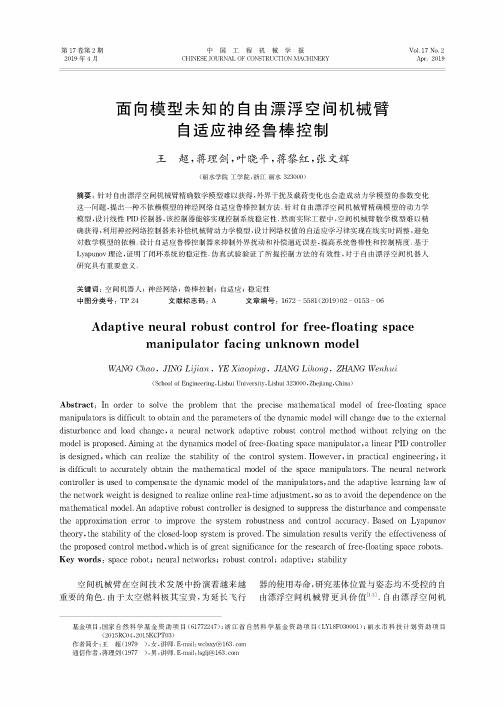
WANGChao, JIN G Lijian, YEXiaoping,JIANGLihong,ZHANG Wenhui (School of Engineering,Lishui University,Lishui 323000,Zhejiang,China)
A bstract:In order to solve the problem that the precise mathematical model of free-floating space
确 获 得 ,利用神经网络控制器来补偿机械臂动力学模型, 设计网络权值的自适应学习律实现在线实时调整,避免
对 数 学 模 型 的 依 赖 .设 计 自 适 应 鲁 棒 控 制 器 来 抑 制 外 界 扰 动 和 补 偿 逼 近 误 差 ,提 高 系 统 鲁 棒 性 和 控 制 精 度 .基 于 Lyapunov理 论 ,证明了闭环系统的稳定性.仿真试验验证了所提控制方法的有效性,对于自由漂浮空间机器人 研究具有重要意义.
关 键 词 :空 间 机 器 人 '神 经 网 络 '鲁 棒 控 制 '自 适 应 ;稳定性
中图分类号!T P 24
文献标志码: A
文 章 编 号 !1672- 5581(2019)02-0153 - 06
Adaptive neural robust control for free-floatin* space manipulator facin* unknown model
manipulators is difficult ot obtain and the parameters of the dynamic model will change due to the external
Robust Control
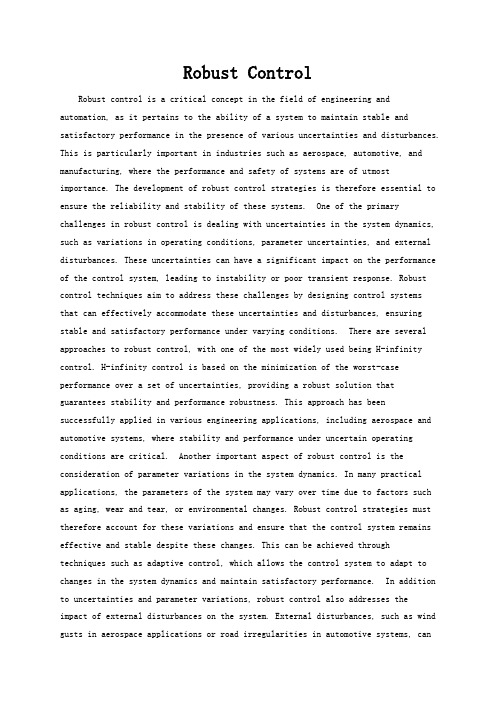
Robust ControlRobust control is a critical concept in the field of engineering and automation, as it pertains to the ability of a system to maintain stable and satisfactory performance in the presence of various uncertainties and disturbances. This is particularly important in industries such as aerospace, automotive, and manufacturing, where the performance and safety of systems are of utmost importance. The development of robust control strategies is therefore essential to ensure the reliability and stability of these systems. One of the primary challenges in robust control is dealing with uncertainties in the system dynamics, such as variations in operating conditions, parameter uncertainties, and external disturbances. These uncertainties can have a significant impact on the performance of the control system, leading to instability or poor transient response. Robust control techniques aim to address these challenges by designing control systemsthat can effectively accommodate these uncertainties and disturbances, ensuring stable and satisfactory performance under varying conditions. There are several approaches to robust control, with one of the most widely used being H-infinity control. H-infinity control is based on the minimization of the worst-case performance over a set of uncertainties, providing a robust solution that guarantees stability and performance robustness. This approach has been successfully applied in various engineering applications, including aerospace and automotive systems, where stability and performance under uncertain operating conditions are critical. Another important aspect of robust control is the consideration of parameter variations in the system dynamics. In many practical applications, the parameters of the system may vary over time due to factors such as aging, wear and tear, or environmental changes. Robust control strategies must therefore account for these variations and ensure that the control system remains effective and stable despite these changes. This can be achieved throughtechniques such as adaptive control, which allows the control system to adapt to changes in the system dynamics and maintain satisfactory performance. In addition to uncertainties and parameter variations, robust control also addresses theimpact of external disturbances on the system. External disturbances, such as wind gusts in aerospace applications or road irregularities in automotive systems, cansignificantly affect the performance of the control system. Robust control techniques aim to mitigate the effects of these disturbances by designing control systems that can effectively reject or accommodate them, ensuring stable and reliable performance in the presence of such disturbances. From a practical perspective, the development and implementation of robust control strategies require a deep understanding of system dynamics, control theory, and mathematical modeling. Engineers and researchers in this field must possess strong analytical and problem-solving skills to design effective robust control systems that meet the performance requirements of the application. Moreover, the practical implementation of robust control strategies often involves the use of advanced control algorithms, real-time computing, and hardware-in-the-loop testing, requiring expertise in control system design and implementation. Furthermore, the development of robust control strategies also involves a trade-off between performance and robustness. While robust control techniques aim to ensurestability and satisfactory performance under uncertainties and disturbances, there is often a trade-off with the achievable performance of the system. Designing robust control systems that strike the right balance between performance and robustness is therefore a key challenge in this field, requiring careful consideration of the specific requirements and constraints of the application. In conclusion, robust control is a critical concept in engineering and automation, addressing the challenges of uncertainties, parameter variations, and external disturbances in control systems. The development of robust control strategies is essential to ensure the reliability, stability, and performance of systems in various industrial applications. Engineers and researchers in this field must possess strong analytical and problem-solving skills, as well as expertise in control theory and system dynamics. The trade-off between performance and robustness is also an important consideration in the design of robust control systems, requiring a careful balance to meet the specific requirements of the application. Overall, robust control plays a crucial role in ensuring the effectiveness and reliability of control systems in the presence of uncertainties and disturbances, making it a key area of focus in the field of engineering and automation.。
- 1、下载文档前请自行甄别文档内容的完整性,平台不提供额外的编辑、内容补充、找答案等附加服务。
- 2、"仅部分预览"的文档,不可在线预览部分如存在完整性等问题,可反馈申请退款(可完整预览的文档不适用该条件!)。
- 3、如文档侵犯您的权益,请联系客服反馈,我们会尽快为您处理(人工客服工作时间:9:00-18:30)。
105
Adaptive Robust Control for a Class of Uncertain MIMO Non-affine Nonlinear Systems
Longsheng Chen and Qi Wang
Abstract—In this paper, the adaptive robust tracking control scheme is proposed for a class of multi-input and multioutput (MIMO) non-affine systems with uncertain structure and parameters, unknown control direction and unknown external disturbance based on backstepping technique. The MIMO nonaffine system is first transformed into a time-varying system with strict feedback structure using the mean value theorem, and then the bounded time-varying parameters are estimated by adaptive algorithms with projection. To handle the possible “controller singularity” problem caused by unknown control direction, a Nussbaum function is employed, and the dynamic surface control (DSC) method is applied to solve the problem of “explosion of complexity” in backstepping control. It is proved that the proposed control scheme can guarantee that all signals of the closed-loop system are bounded through Lyapunov stability theorem and decoupled backstepping method. Simulation results are presented to illustrate the effectiveness of the proposed control scheme. Index Terms—MIMO non-affine nonlinear system, dynamic surface control (DSC), Nussbaum function, adaptive robust control
I. I NTRODUCTION N the past several decades, the control methods for uncertain nonlinear system have received much attention and a lot of results have been achieved, such as adaptive feedback linearization technique, adaptive backstepping technique, fuzzy control and neural network control etc.[1−9] , but most of the studies are based on affine systems in which the control inputs appear in a linear fashion. In practice, there are many nonlinear systems with non-affine structure in which the control inputs are embedded nonlinearly into the system through various possible ways[10−12] , such as chemical reactors, biochemical process, aircraft dynamics, dynamic model in pendulum control etc. Control design for non-affine systems has become an innovative and challenging topic, and some remarkable results have been obtained. Generally, the studies for the control problem of non-affine system can be broadly classified in three categories. In the first category, the control methods are focused on transforming the original system non-affine into a new system
I
Manuscript received November 2015. This work was supported by the Aerospace Science and Technology Innovation Foundation of China (CAST2014CH01), the Aeronautical Science Foundation of China (2015ZC560007), the Jiangxi Natural Science Foundation of China (20151BBE50026), and National Natural Science Foundation of China (11462 015). Recommended by Associate Editor Yungang Liu. Citation: Longsheng Chen, Qi Wang. Adaptive robust control for a class of uncertain MIMO non-affine nonlinear systems. IEEE/CAA Journal of Automatica Sinica, 2016, 3(1): 105−112 Longsheng Chen and Qi Wang are with the College of Aircraft Engineering, Nanchang Hangkong University, Nanchang 330063, China (e-mail: lschen2008@; wangqi439@).
